The Radeon RX 6600 XT is AMD's latest mainstream GPU release, expected to land on retailers' shelves a day after this review goes live, that is, immediate availability on August 11. Naturally, the $380 MSRP is a mere indication of the actual street price for this product.
Expect to pay a hefty premium due to the shortages, cryptomining and scalping going around. If we use the 6700 XT as a price guide, you can expect to pay around $600 for the 6600 XT. We'll save the detailed retail pricing discussion for later when examining the cost per frame data, for now let's focus on the claimed MSRP, which sees the 6600 XT coming in at a 21% discount when compared to the 6700 XT.

We're looking at new silicon with the 6600 XT as the Navi 23 GPU is based on a 237mm2 die packing 11.1 billion transistors, almost a billion more than the older 5700 XT. Enabled are 32 compute units providing 2048 stream processors, 128 TAUs and 64 ROPs. That's a 20% reduction in cores and TAUs when compared to the 6700 XT.
The 6600 XT suffers a substantial downgrade to the memory subsystem, dropping from a 192-bit wide bus to a 128-bit memory bus, a 33% reduction which means that despite using the same 16 Gbps GDDR6 memory, the bandwidth has also been reduced by 33%, dropping from 384 GB/s to just 256 GB/s.

Memory capacity has also been reduced from 12GB to 8GB. AMD is targeting 1080p gaming with the 6600 XT, and they suggest 8GB of VRAM is suitable for this resolution in 2021. The downgrades don't stop there either. The Infinity Cache has been slashed by a massive 67%, reducing it from 96 MB down to 32 MB and with that bandwidth has dropped from 1459 GB to 922 GB, a 37% reduction.
Put differently, the Radeon 6600 XT is 21% cheaper than the 6700 XT and on paper it appears it's going to be at least 20% slower.

Interestingly, AMD's been keen to suggest that the 6600 XT competes with the RTX 3060, rather than the 3060 Ti. But we're having none of that, at $380 it's 15% more expensive than the 3060 and just 5% cheaper than the 3060 Ti. So a bit cheeky there and in reality AMD's is barely offering a $20 discount for a product that will no doubt deliver lackluster ray tracing performance. While we like FSR so far, it's by no means good enough to neutralize the DLSS threat either.

Another potential issue is that AMD has gimped the PCI Express interface and although it still uses PCIe 4.0, the bandwidth has been reduced to x8. When installed in a PCIe 4.0 system this is a non-issue, but performance related problems could arise when installed in a system that only supports PCIe 3.0, which right now is most systems.
This is because when using PCIe 4.0, the Radeon 6600 XT connects to the CPU using a 16GB/s link which is sufficient for modern graphics cards as that's what you get with PCIe 3.0 x16. However, when limited to an x8 interface the bandwidth for a PCIe 3.0 system is reduced to just 8 GB/s, and we've found in the past this can heavily limit performance, especially when fetching data from system memory. We'll look at PCIe 3.0 vs 4.0 performance a little later on.

Let's now go over some benchmarks using the MSI Gaming X model we have on hand. All benchmark results are based on AMD and Nvidia GPUs running at the official specs, with no factory overclocking. In total, we've tested 12 games at 1080p and 1440p using our Ryzen 9 5950X test system which has been configured with 32GB of dual-rank, dual-channel DDR4-3200 CL14 memory.
Benchmarks
Starting with Assassin's Creed Valhalla, the 6600 XT gets off to a flyer, beating the RTX 3060 Ti by a convincing 13% margin and the standard 3060 by a massive 31%. We're looking at RTX 3070 Ti-like performance in this game, while still lagging behind the 6700 XT.
That margin was extended at 1440p where the 6600 XT trailed the 6700 XT by 19%, rendering 60 fps on average, which is a solid result.
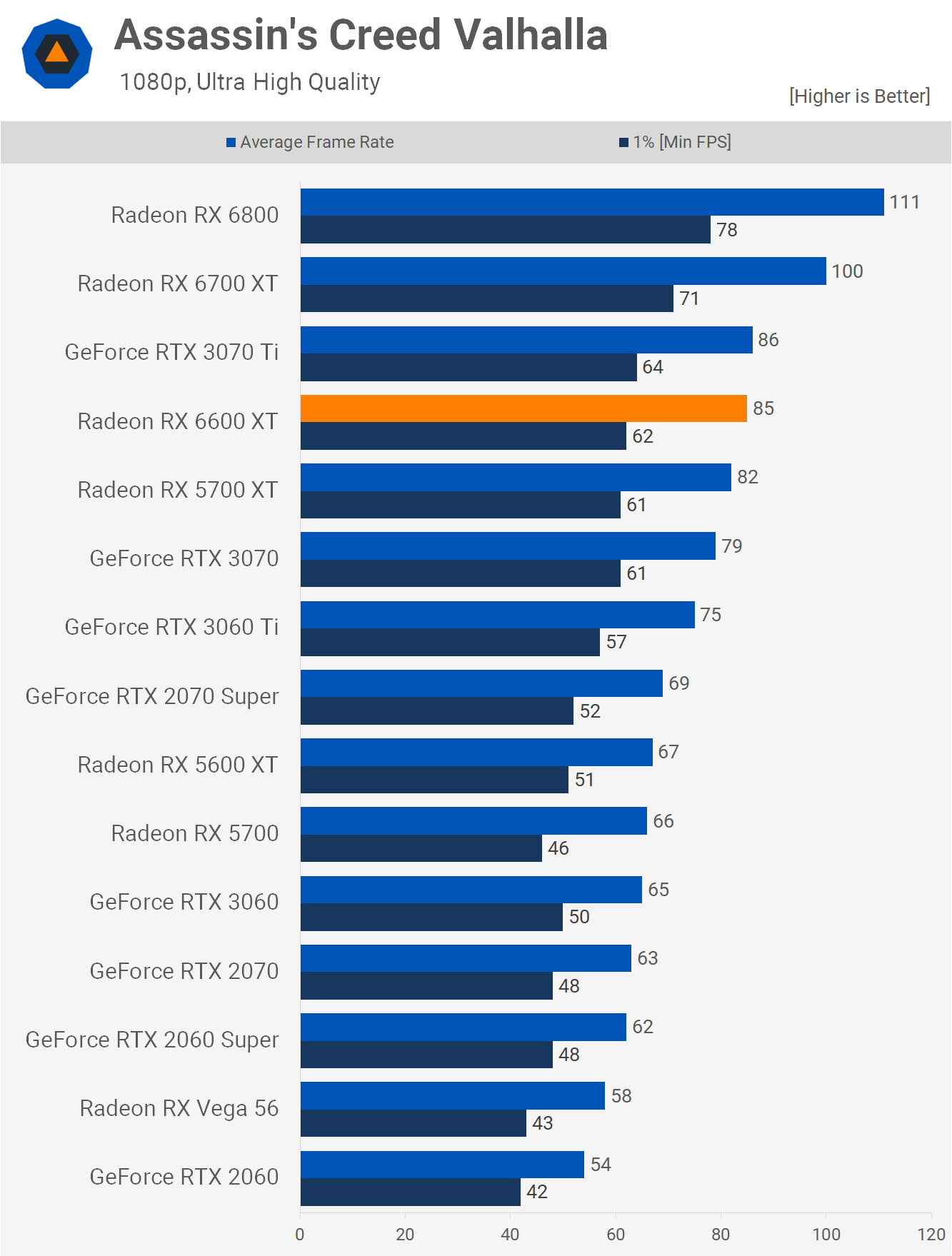
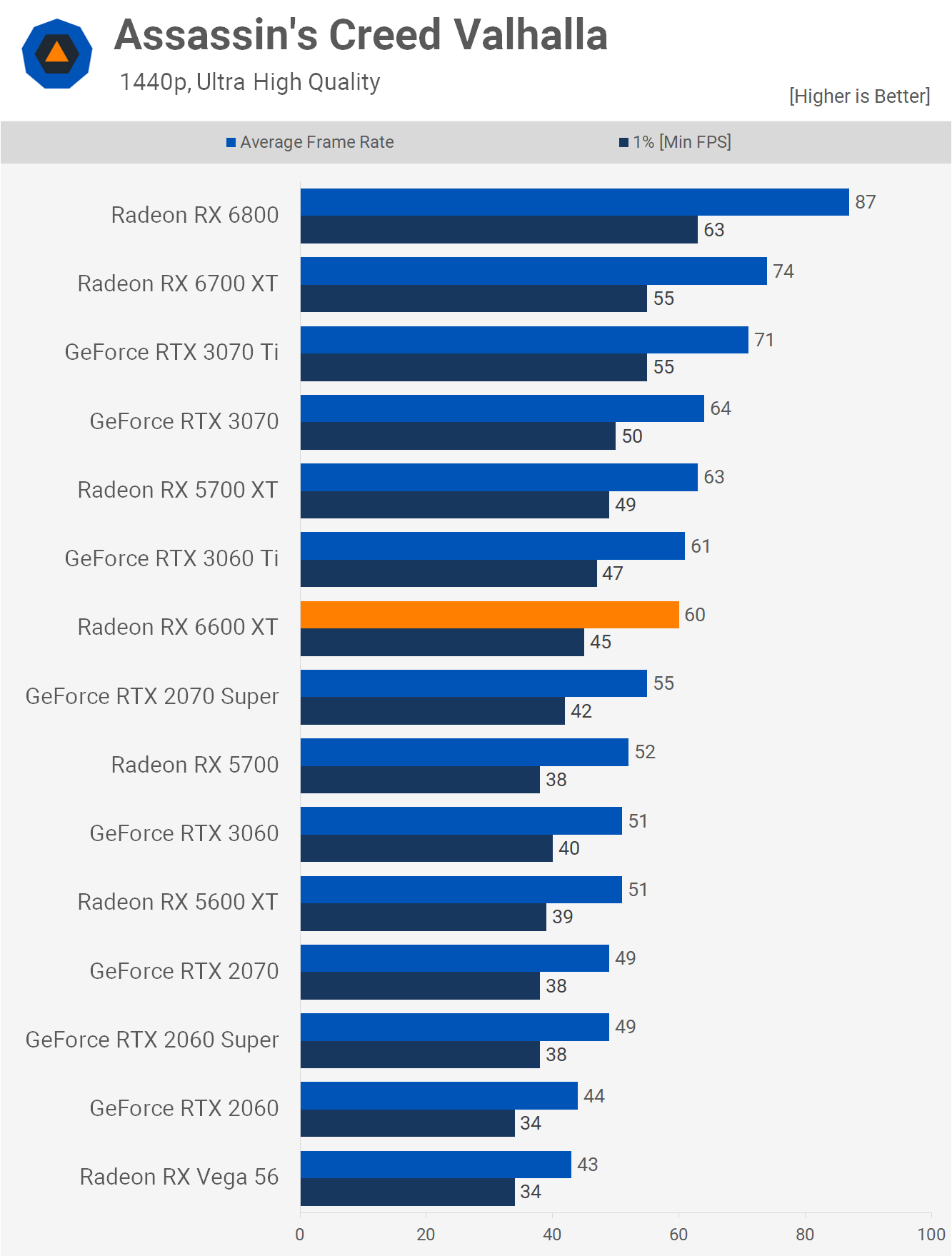
Something worth noting is that the 6600 XT is just 5% slower than the 5700 XT. That's disappointing given it's just 5% cheaper than the 2-year-old Radeon GPU (at MSRP, not the inflated price). So while impressive when compared to GeForce offerings in this AMD-sponsored title, the results are less impressive than they seem.
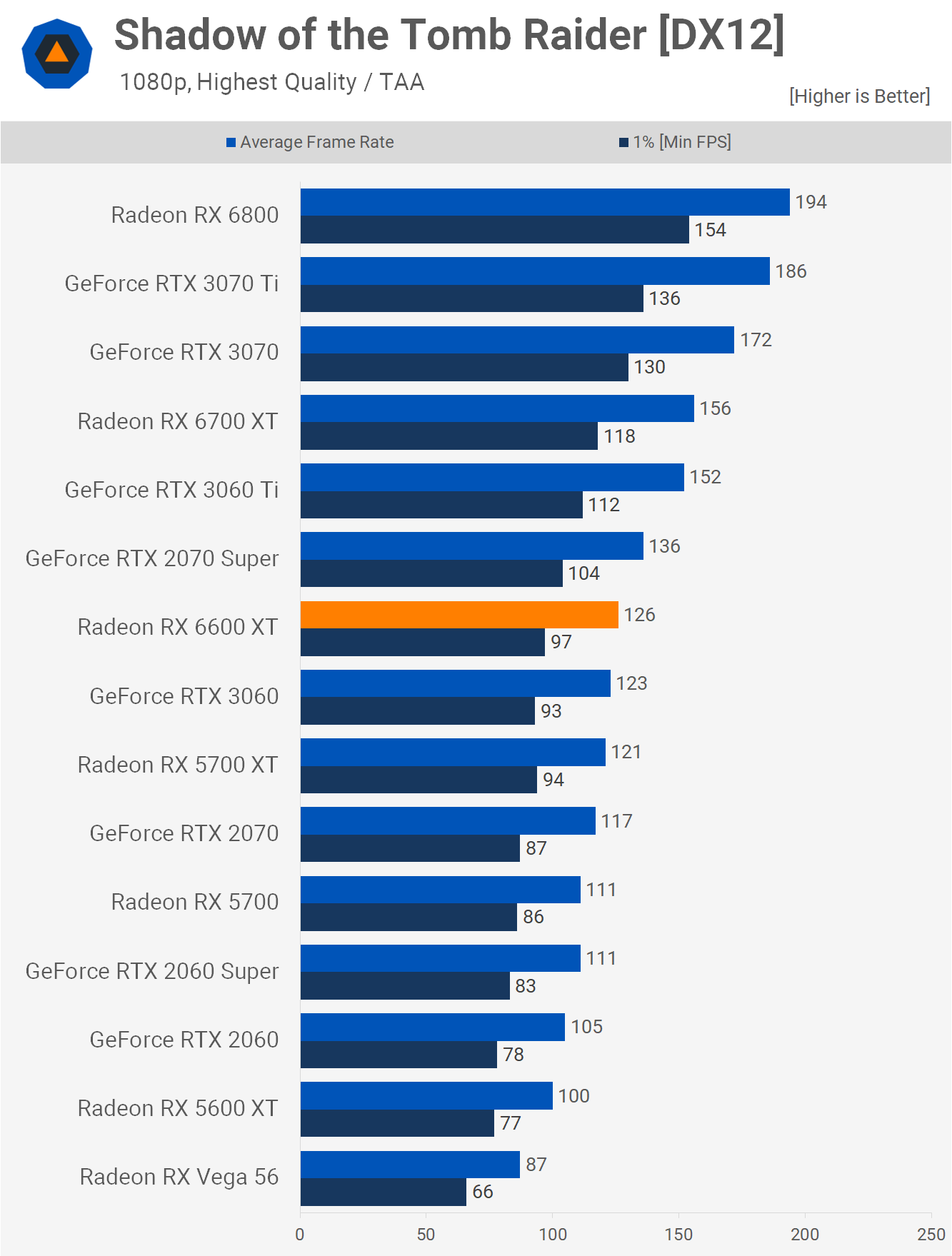
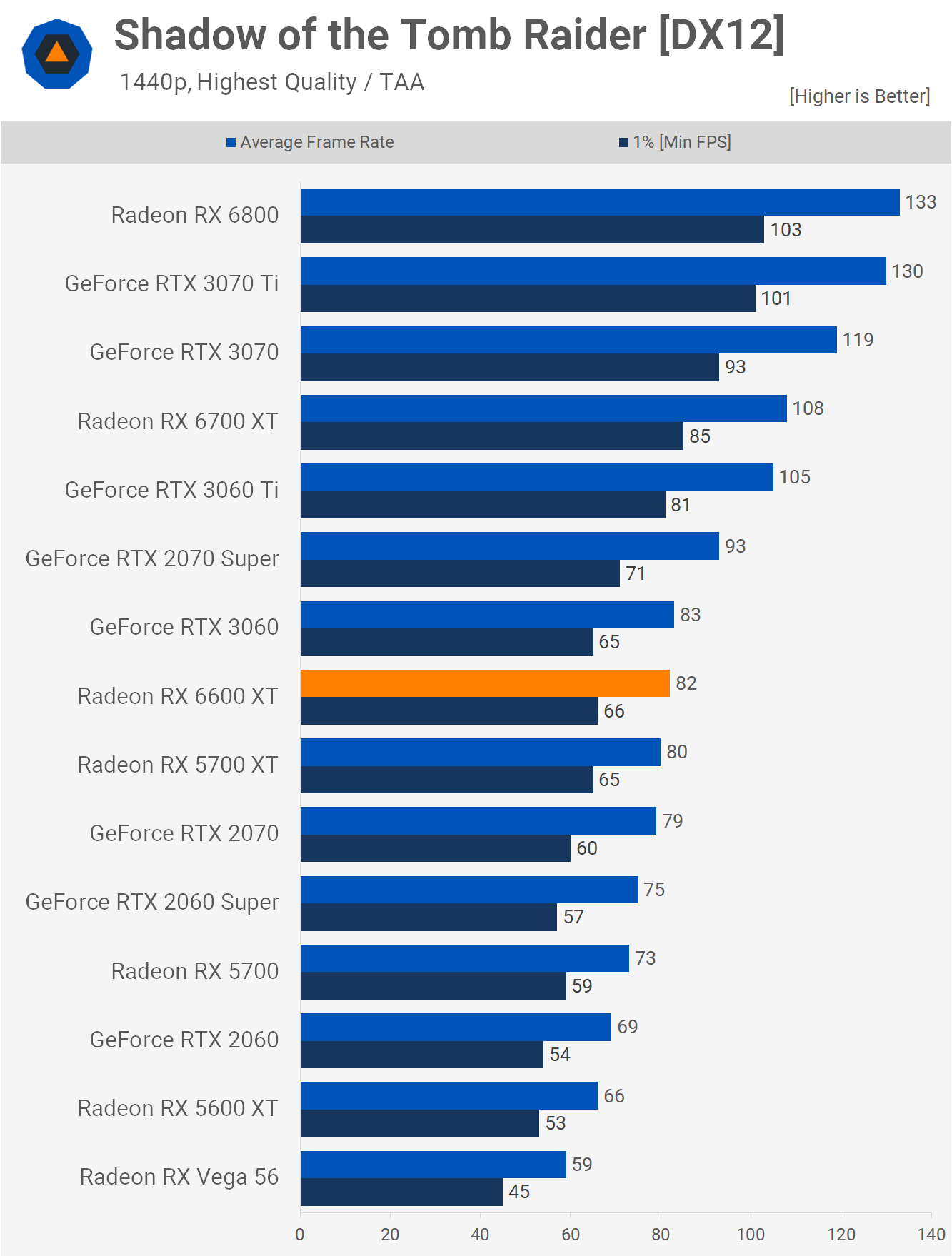
Moving on to Shadow of the Tomb Raider and we've got to say, these results look less favorable for the new mid-range Radeon GPU. Here at 1080p the 6600 XT was 19% slower than the 6700 XT and 17% slower than the RTX 3060 Ti, while it was just 2.5% faster than the 3060 and 4% faster than the old 5700 XT.
The 1440pp data is worse and you can see the 6600 XT suffering due to the more limited memory bandwidth, especially when compared to the 6700 XT which it now trails by a 24% margin. The 6600 XT was only able to match the cheaper RTX 3060 and we're looking at 5700 XT-like performance which is disappointing given the price point.
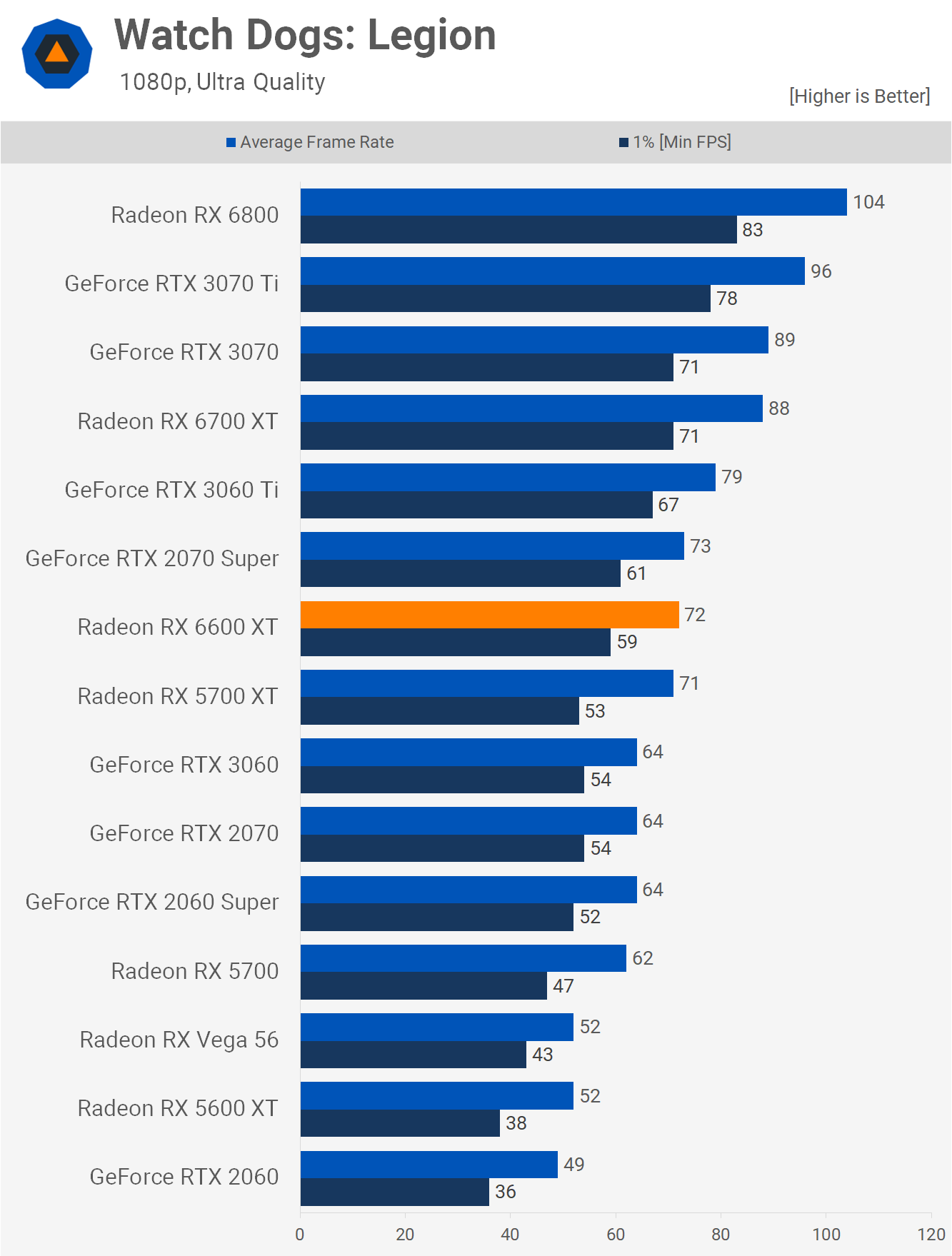
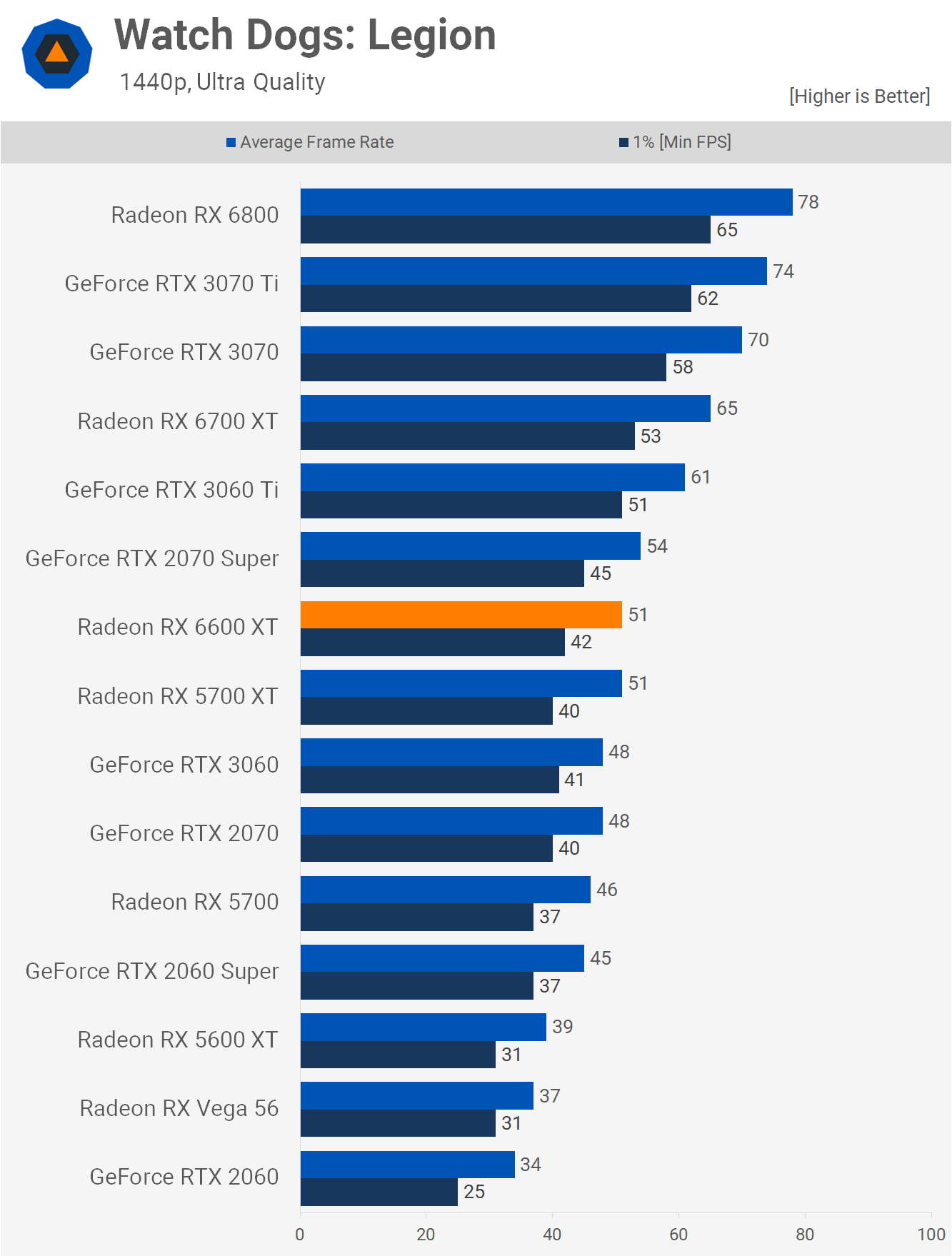
Watch Dogs: Legion is another game where the 6600 XT proves its essentially a 5700 XT in terms of performance. With 72 fps on average, it found itself situated between the RTX 3060 Ti and 3060 at 1080p, but that meant it was 18% slower than the 6700 XT, which isn't a bad result.
You can see why AMD were like 'wink wink nudge nudge' about the whole 6600 XT being a 1080p gaming GPU, they were probably hoping to persuade reviewers to ignore 1440p. Here we see that with 51 fps on average it only matched the 5700 XT and that meant now it was just 6% faster than the RTX 3060 and 16% slower than the 3060 Ti and 22% slower than the 6700 XT, so a weak result at 1440p.
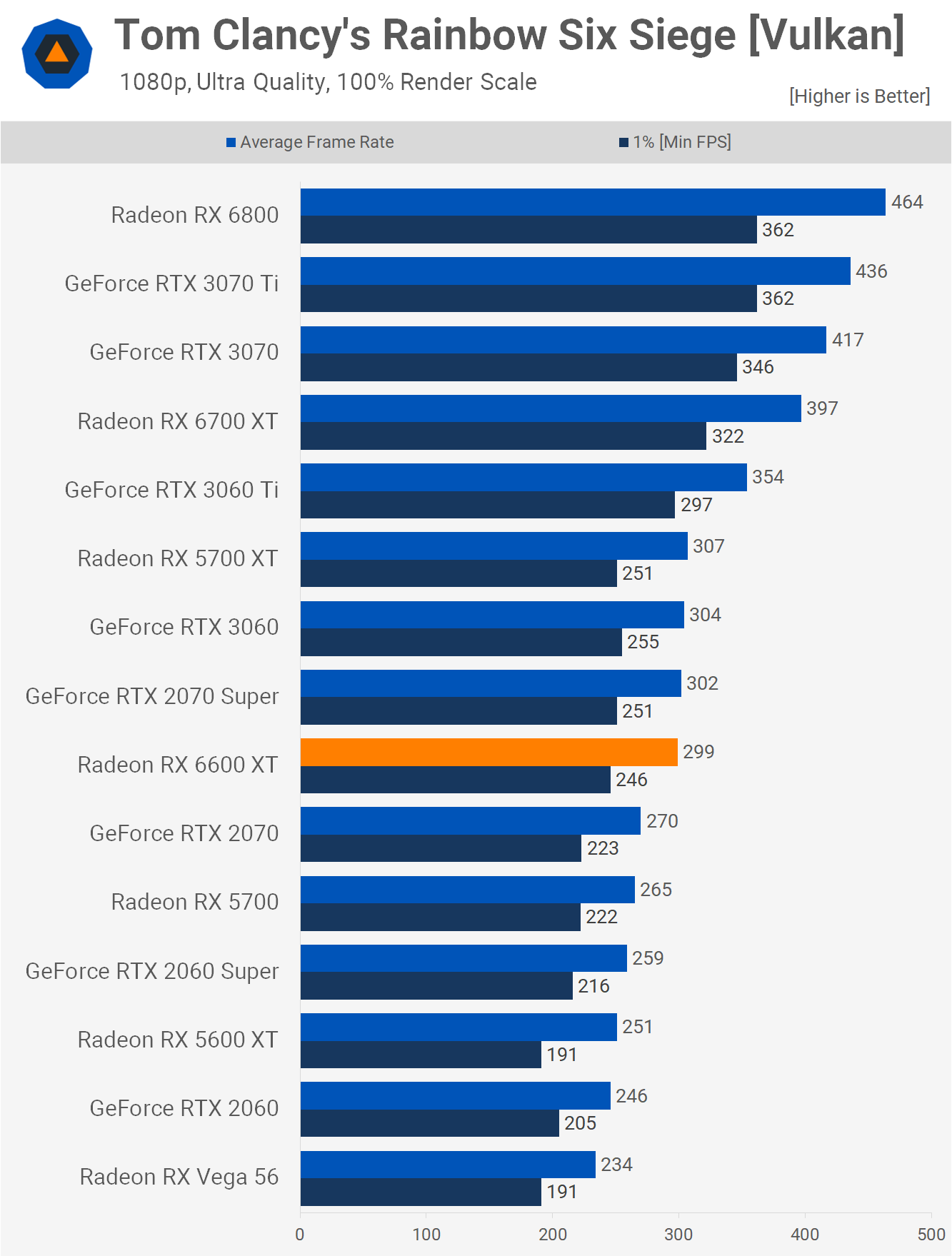
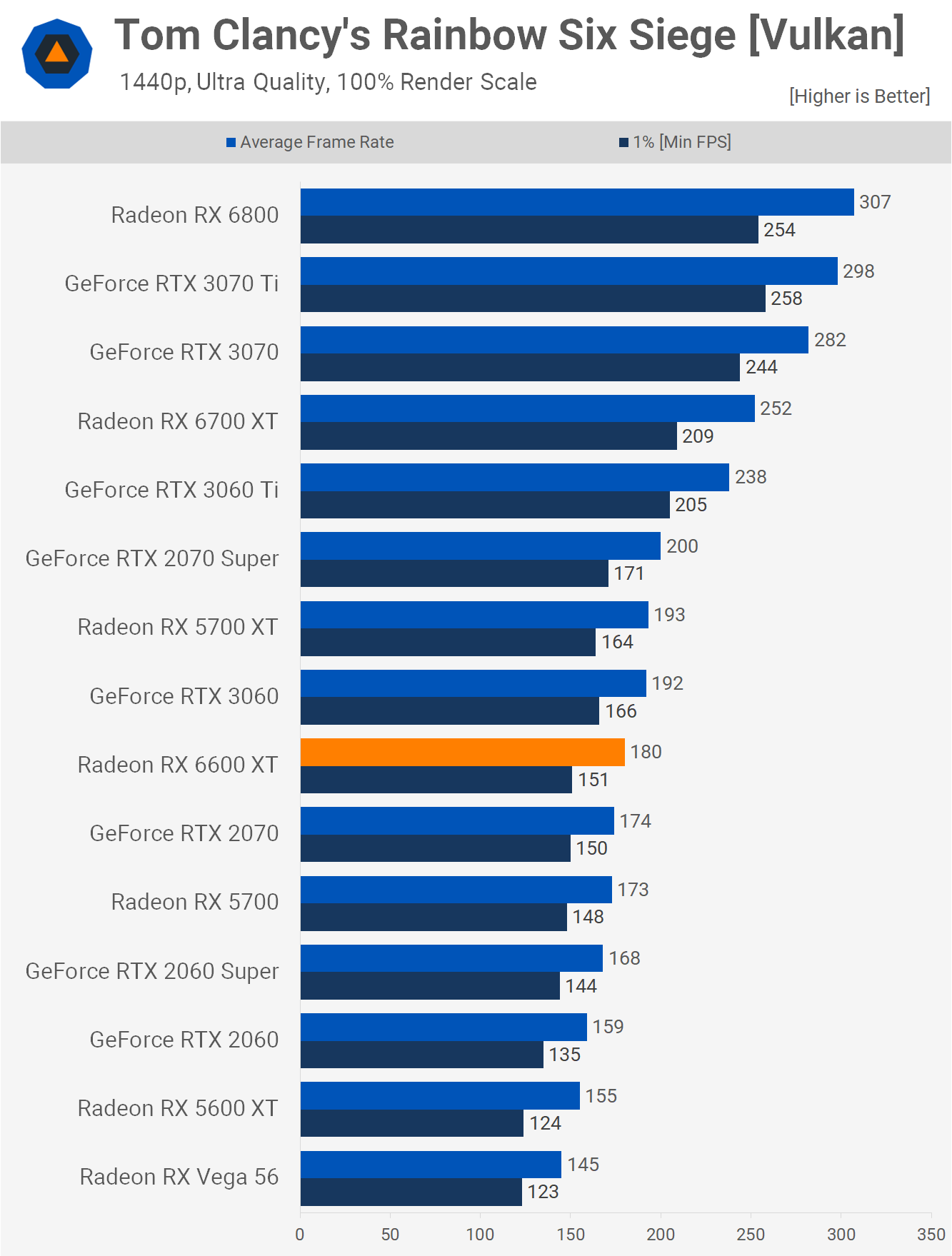
Those of you playing Tom Clancy's Rainbow Six Siege at 1080p probably don't require the 6600 XT, but in case you do, here are the results. The new Radeon GPU was good for around 300 fps on average and that's the same level of performance you'll receive from the old 5700 XT or 2070 Super, or the newer and cheaper RTX 3060. So not a particularly impressive showing given it was 25% slower than the 6700 XT.
As we've seen a number of times now, the margins increase at 1440p and not the way a potential 6600 XT owner would want them to. Here it was 29% slower than the 6700 XT while losing out to the old 5700 XT and the new and cheaper RTX 3060.
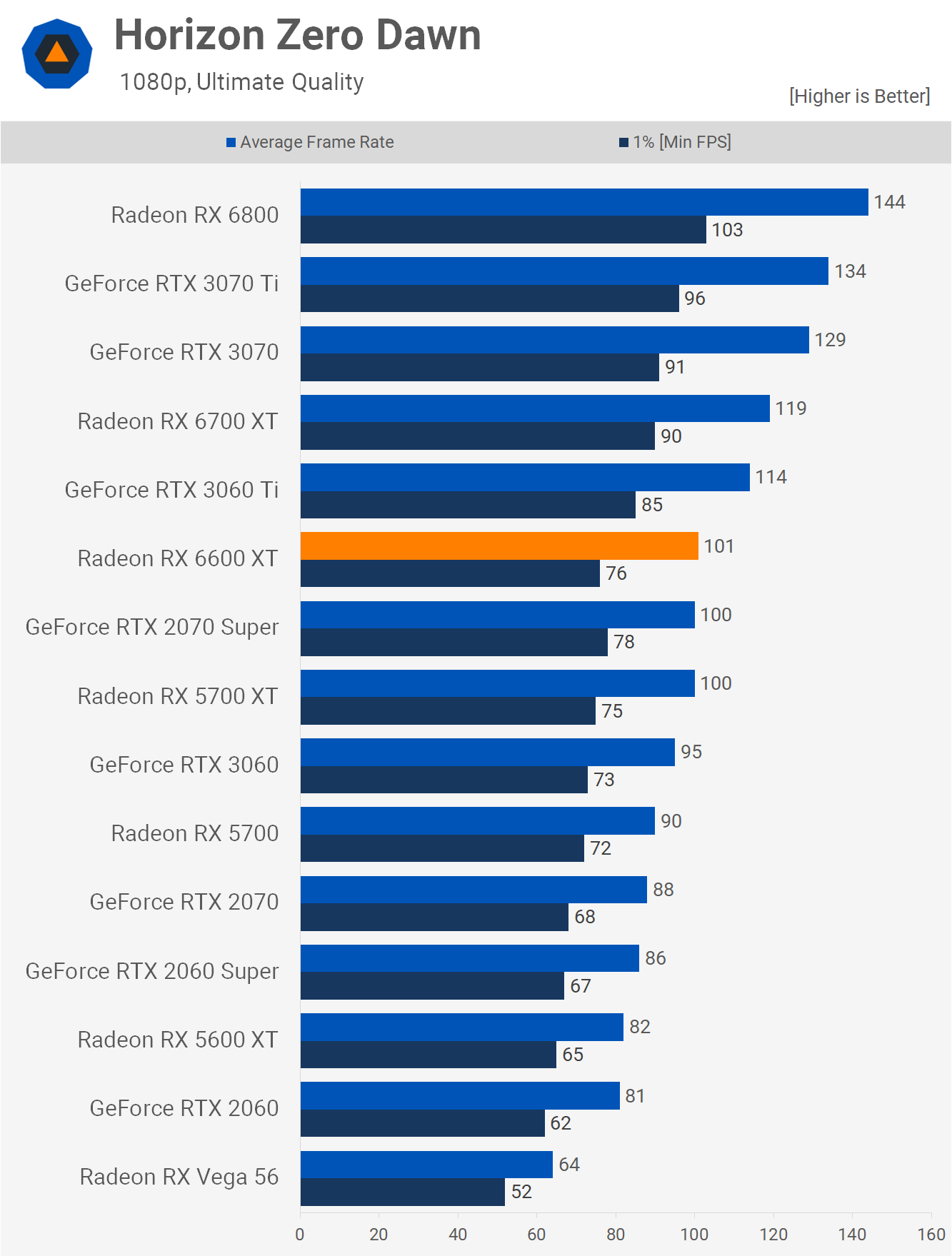
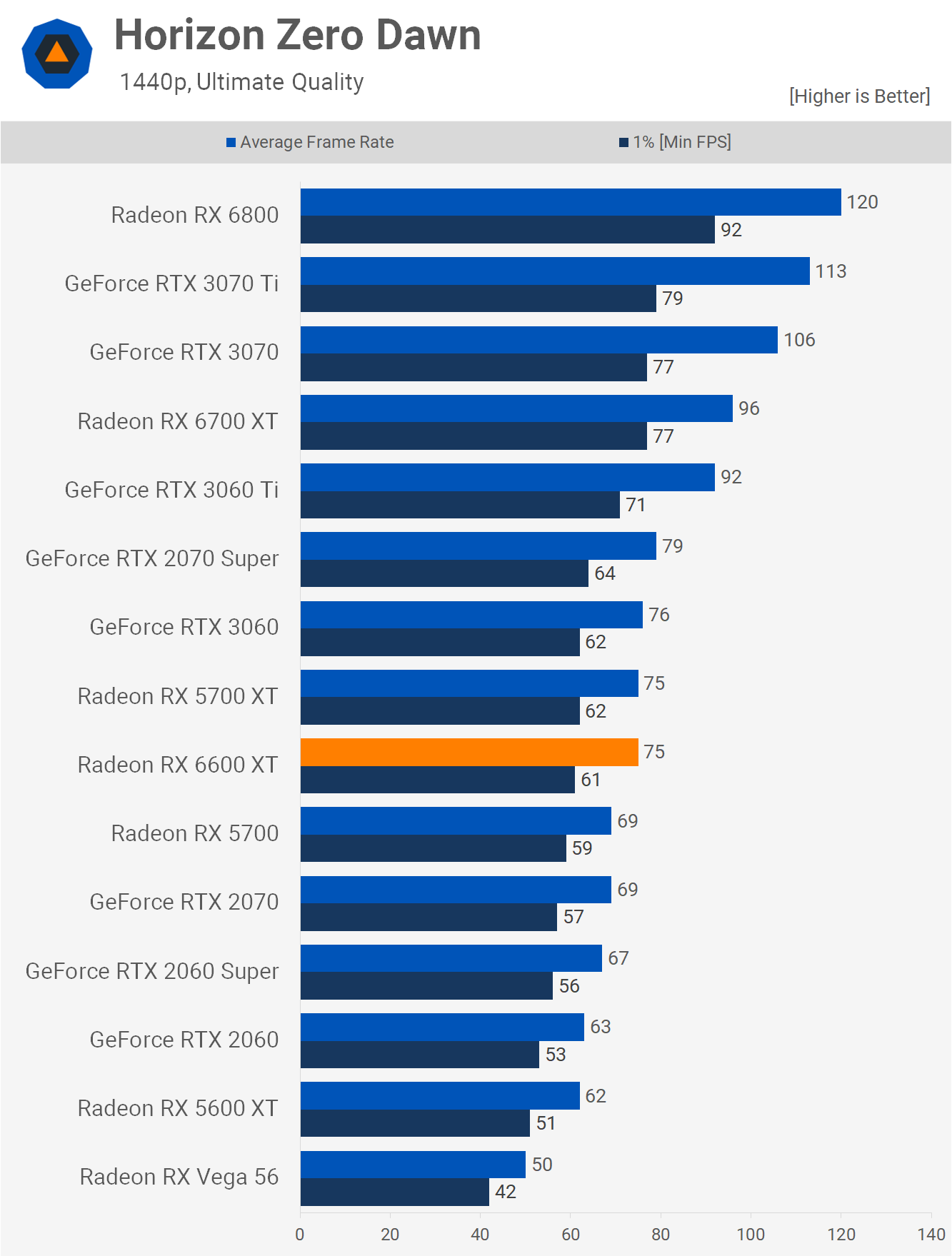
Moving on to Horizon Zero Dawn, we find that at 1080p the new 6600 XT can only match the 5700 XT while offering a very minor improvement over the RTX 3060, and I think it's fair to say that's a disastrous result for the suggested price.
Worse still, the 1440p results favor the cheaper RTX 3060 and now it's able to match the 6600 XT while the 3060 Ti was 23% faster! It does appear as though AMD's competing quite poorly with Nvidia's Ampere lineup at this price point.
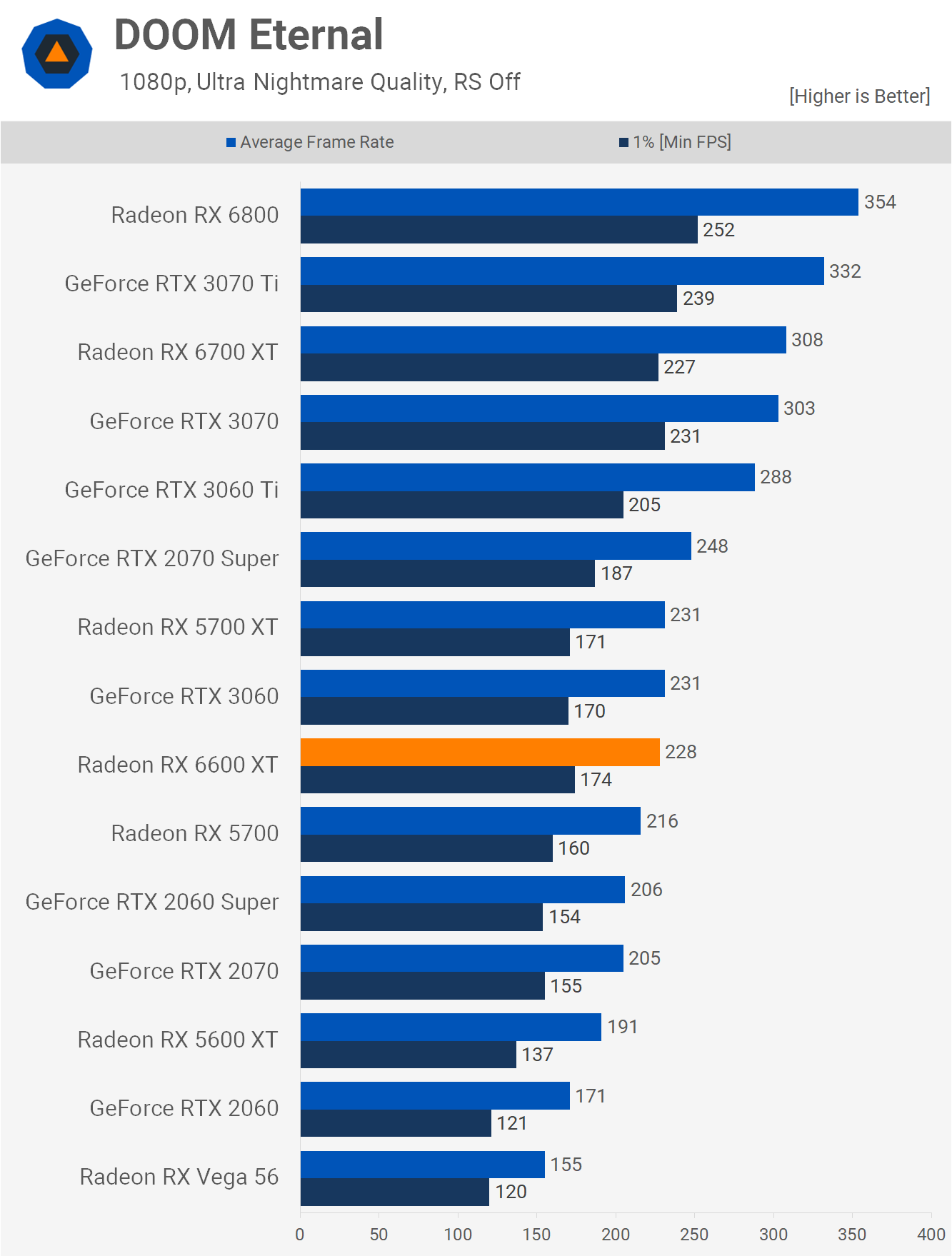
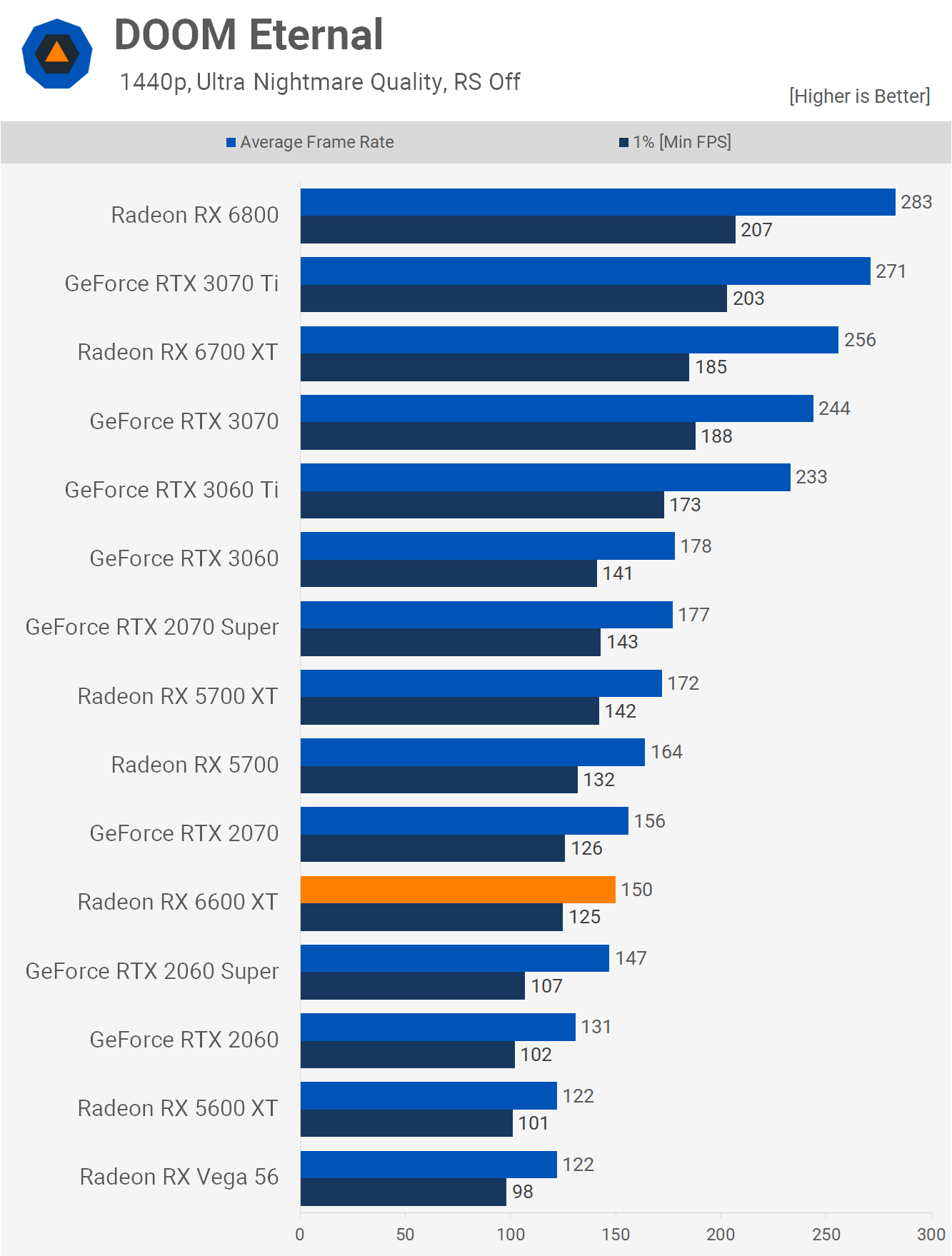
The Doom Eternal frame rates are certainly very high. The 6600 XT had no trouble pushing over 200 fps in our test, though that was only enough to match the RTX 3060 and the old 5700 XT. It was 21% slower than the 3060 Ti and 25% slower than the RTX 3070.
The 1440p results are eye-opening as under these conditions Doom Eternal starts to max out the 8GB VRAM buffer and although it's possible to turn down certain settings in order avoid this, with no real noticeable impact to image quality, we deliberately opt not to do that and instead use this as more of a forward-looking type benchmark.
This is what we expect to see in future memory-demanding titles. The key here is that both the 6600 XT and 3060 Ti use 8GB of VRAM, yet the GeForce GPU is 55% faster, so how can that be? We believe this has more to do with memory bandwidth and the RTX 3060 Ti just has a lot more of it – 75% more, thanks to the wider 256-bit memory bus.
The 5700 XT also enjoys 75% more memory bandwidth though it was only 19% faster, which is still a massive margin and the only reason it's not larger is because shader performance is limited. This is an interesting look at how poorly the 6600 XT performs relative to competing parts in memory-intensive games.
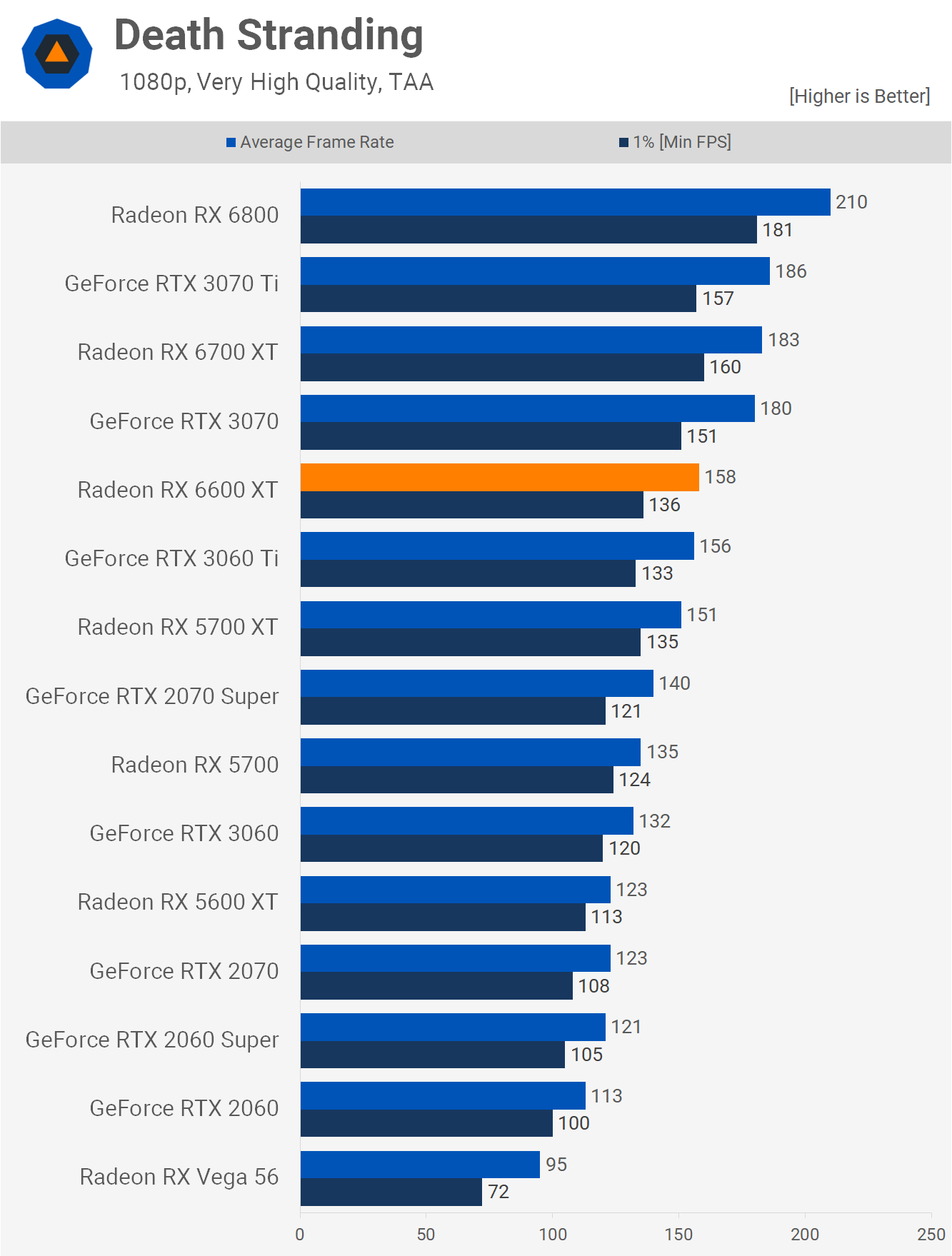
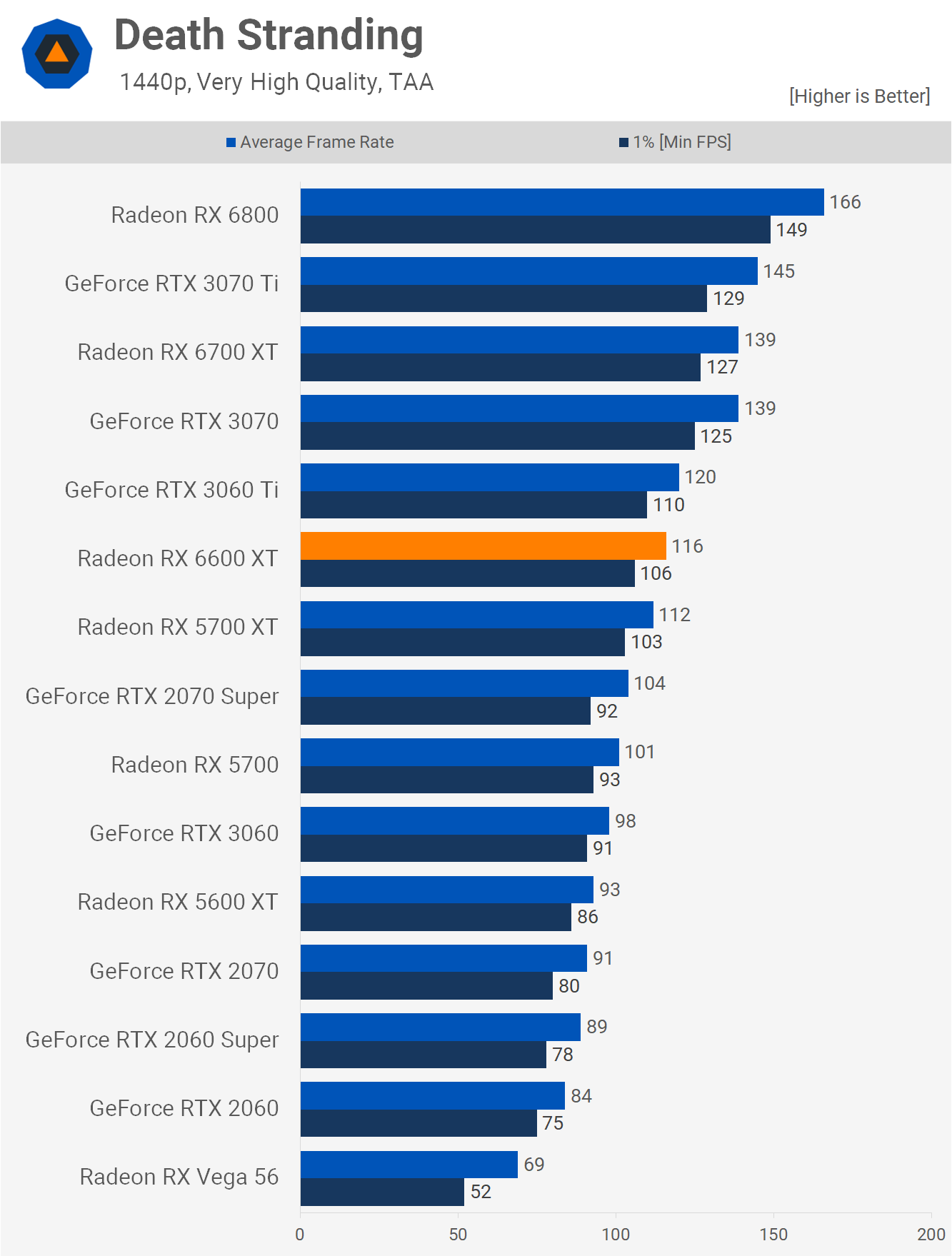
Like most Radeon GPUs, the 6600 XT performs well in Death Stranding, delivering 158 fps on average at 1080p, allowing it to match the 3060 Ti which frankly should be the minimum level of performance offered by this product.
Jumping to 1440p doesn't change the picture all that much. We're still looking at 5700 XT-like performance, which is also close to the 3060 Ti in this title.
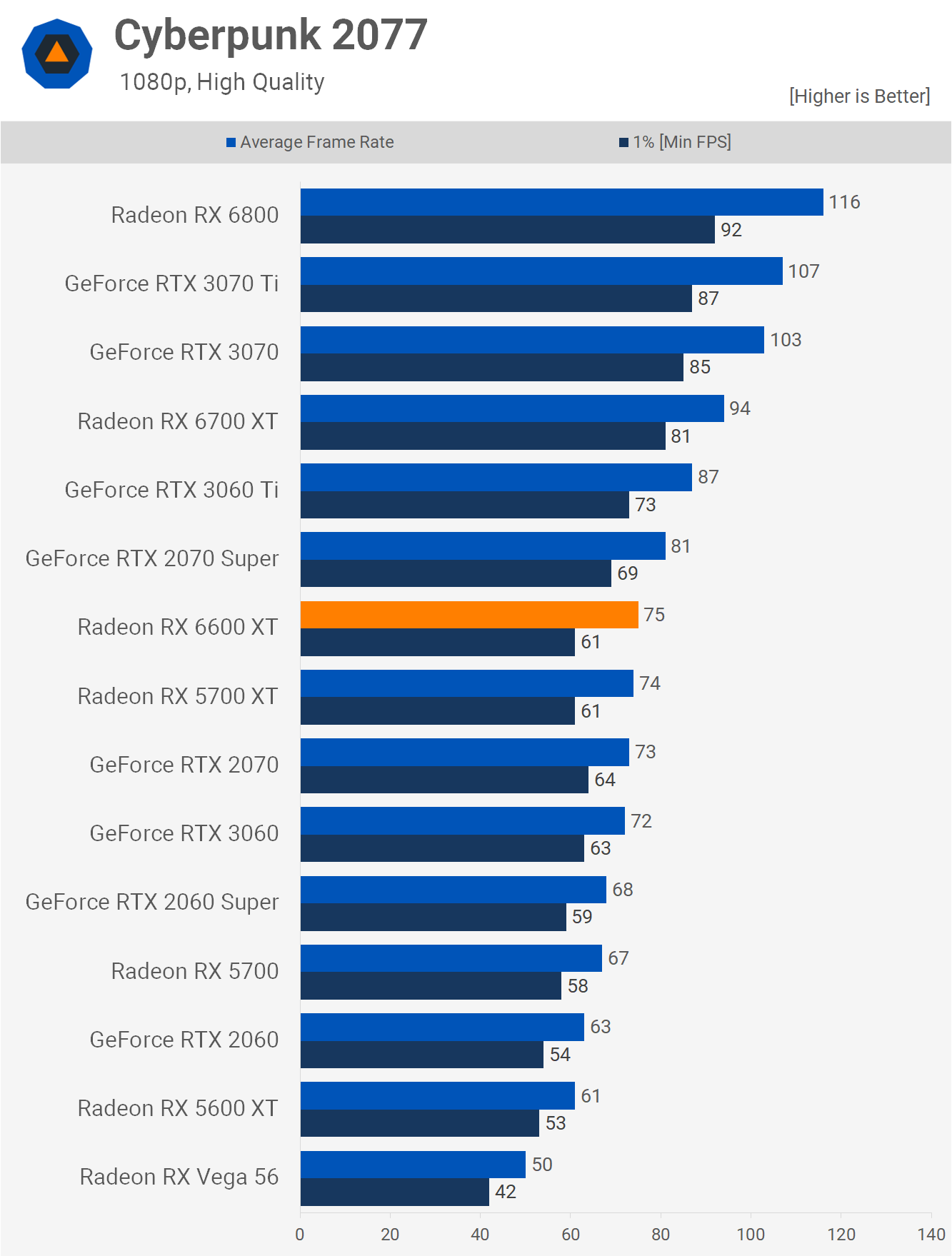
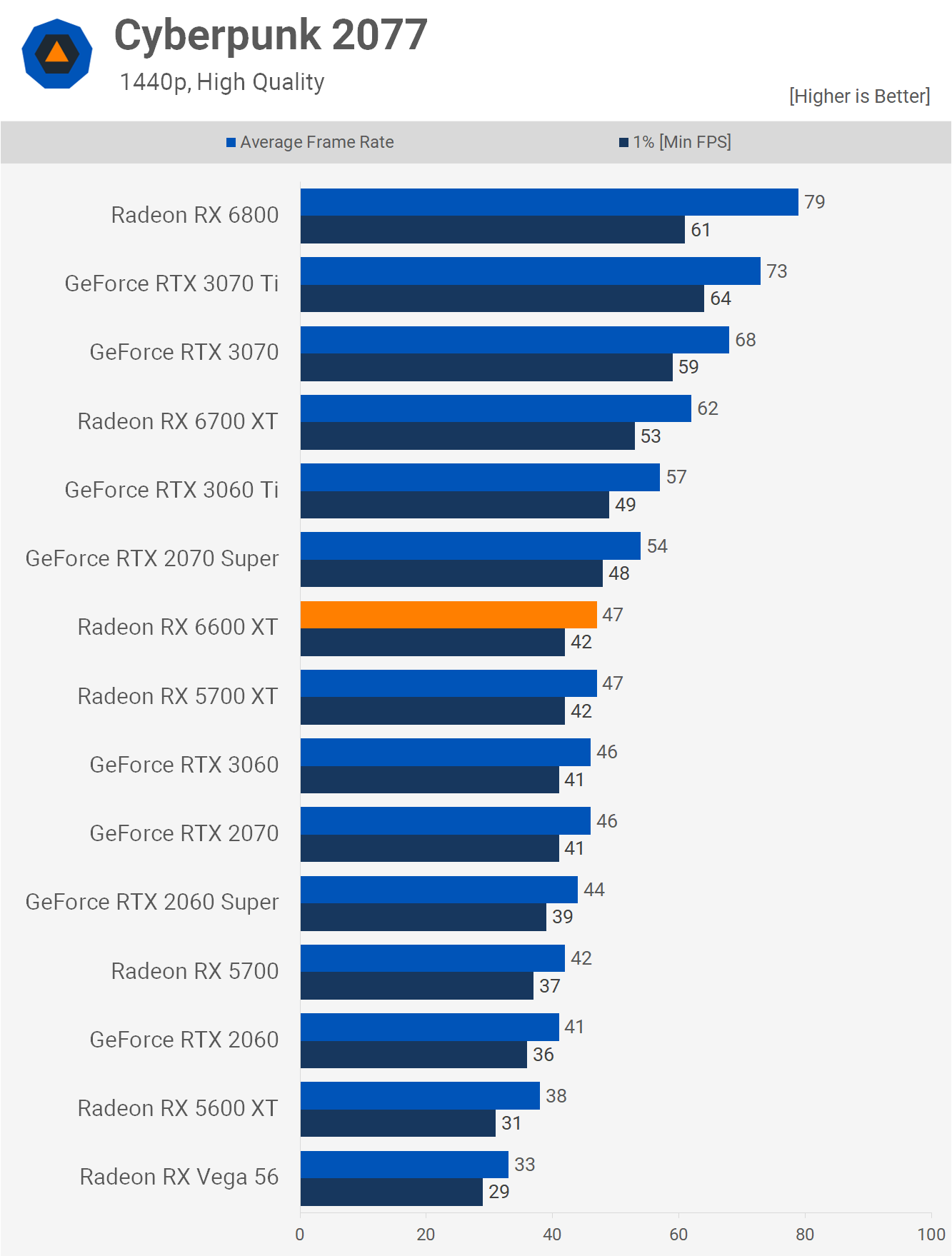
Next up we have Cyberpunk 2077, where the 6600 XT was good for 75 fps on average at 1080p, making it comparable to the 5700 XT, RTX 2070 and RTX 3060. Disappointingly though, it was 14% slower than the 3060 Ti and 20% slower than the 6700 XT.
As expected the margins continue to head in the wrong direction for the 6600 XT when increasing the resolution. At 1440p it's now 18% slower than the 3060 Ti and 24% slower than the 6700 XT.
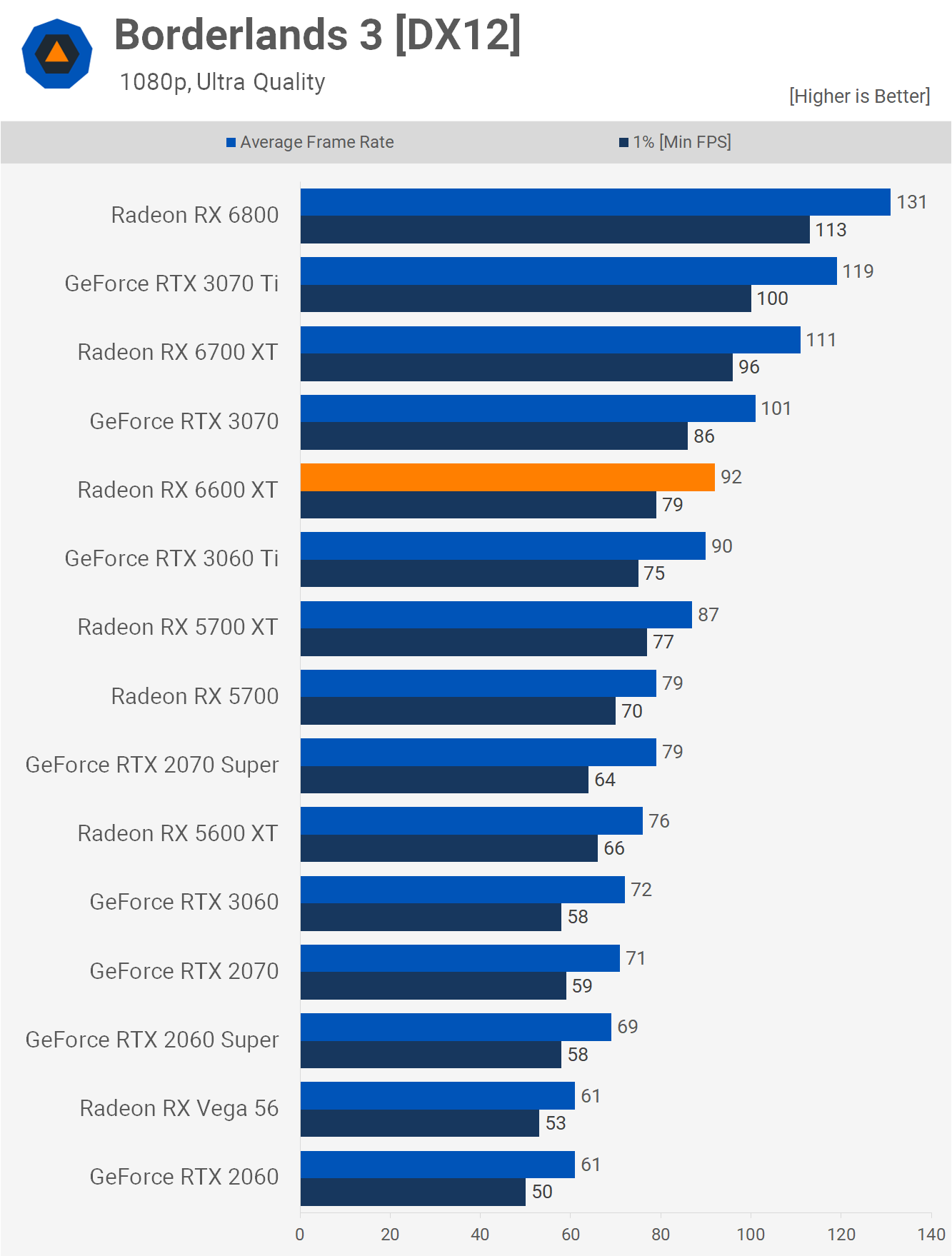
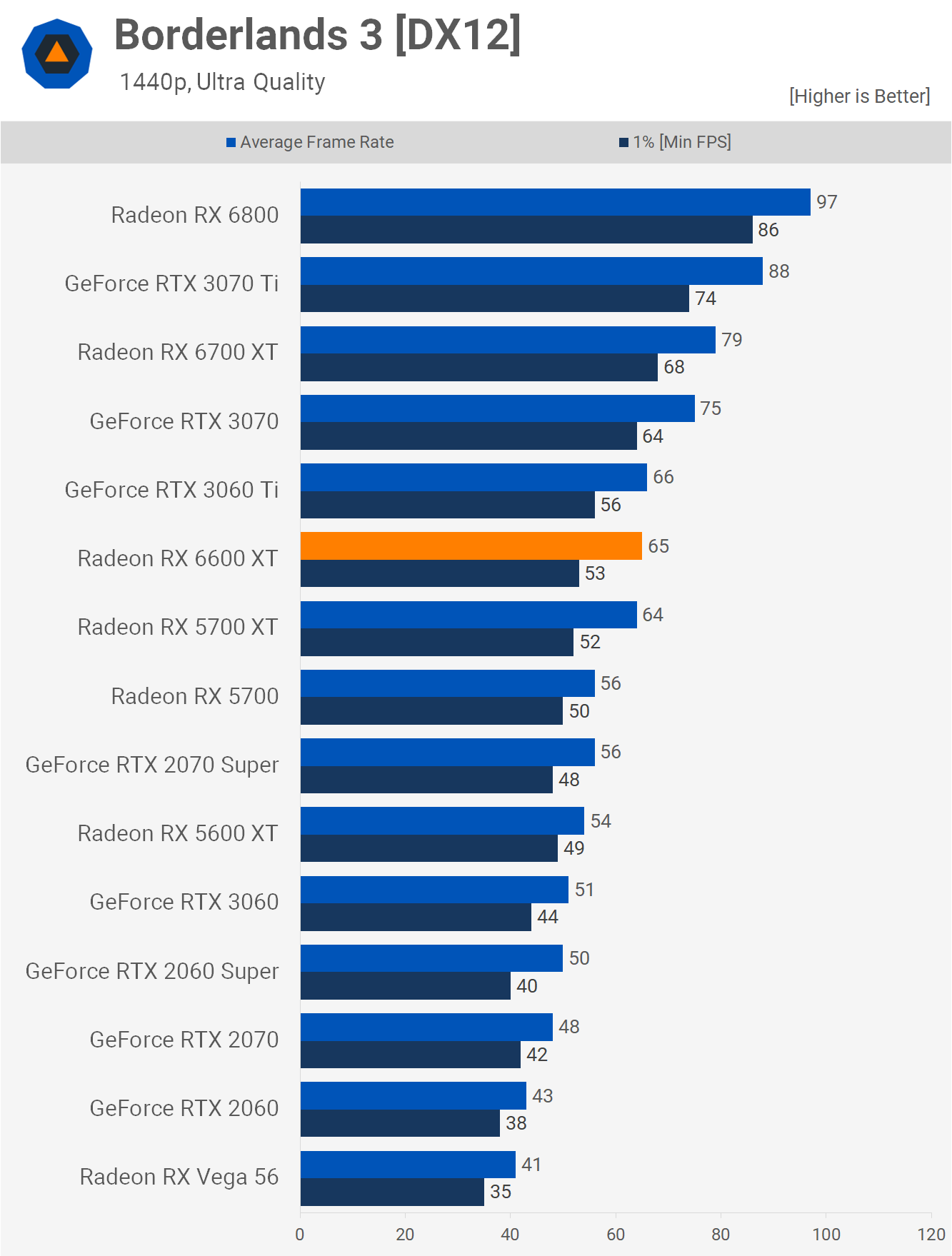
Borderlands 3 is an AMD sponsored title and it does play really well with Radeon GPUs, spitting out 92 fps at 1080p and that allowed it to match the RTX 3060 Ti.
The 1440p margins are about the same. The 6600 XT is able to match the RTX 3060 Ti as it delivered 5700 XT-like performance, which is not amazing and what you'd expect to see at this price point.
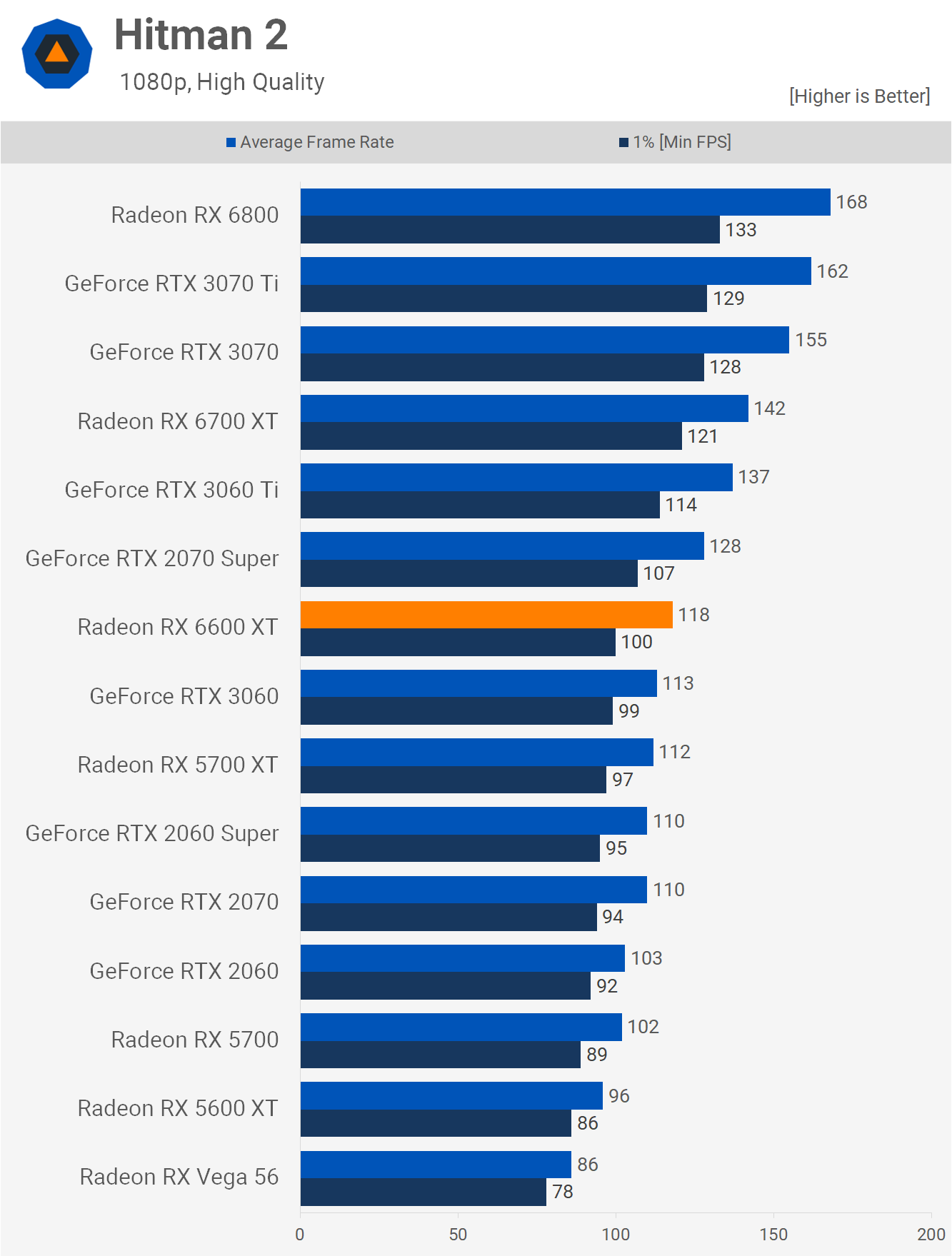
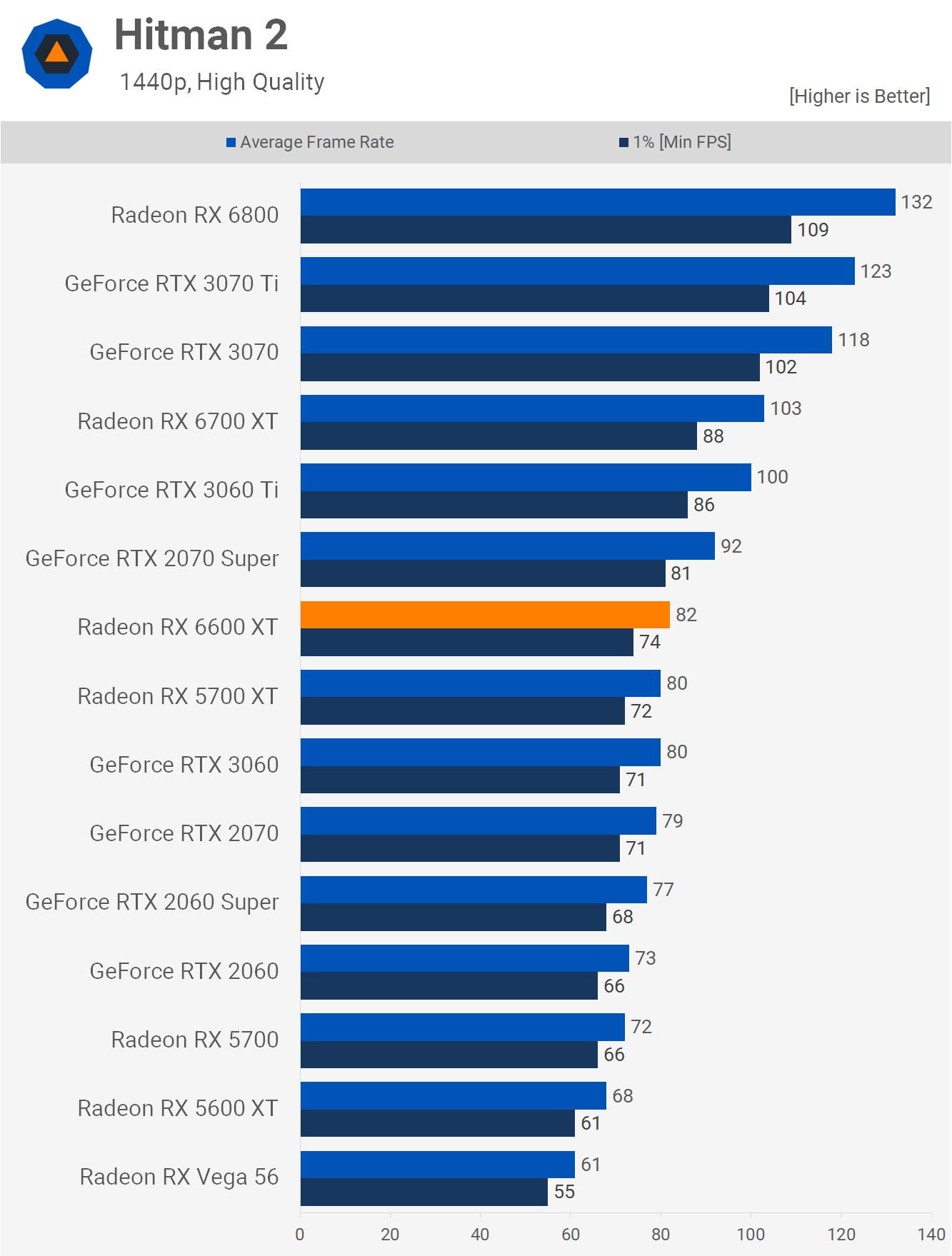
The Hitman 2 results are typical of what we've seen in the majority of titles and that means the 6600 XT performs closer to the RTX 3060 rather than the 3060 Ti, despite being priced closer to the latter. At 1080p, it was 14% slower than the 3060 Ti and just 4% faster than the 3060. As we've seen time and time again, the margins extend slightly in Nvidia's favor at 1440p.
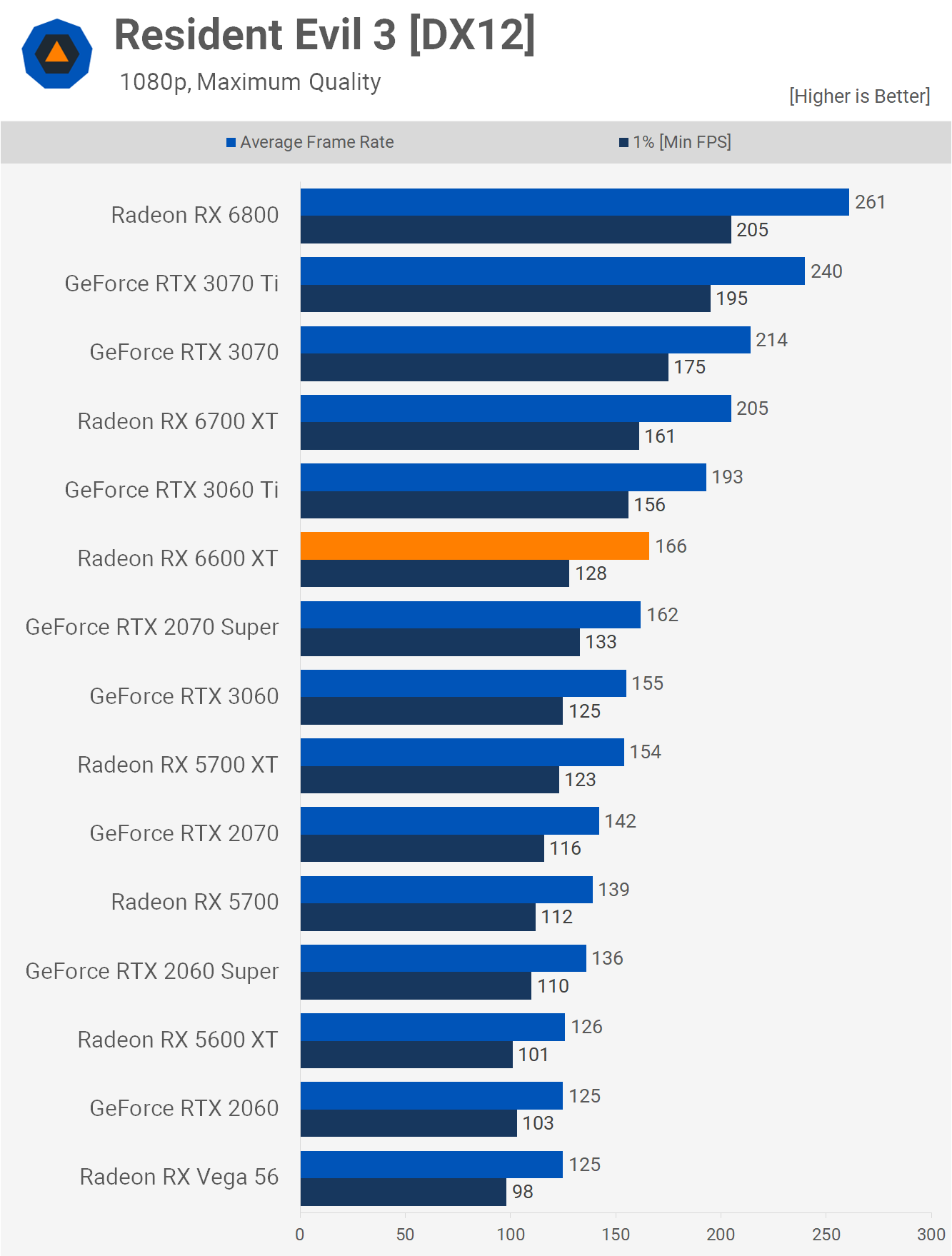
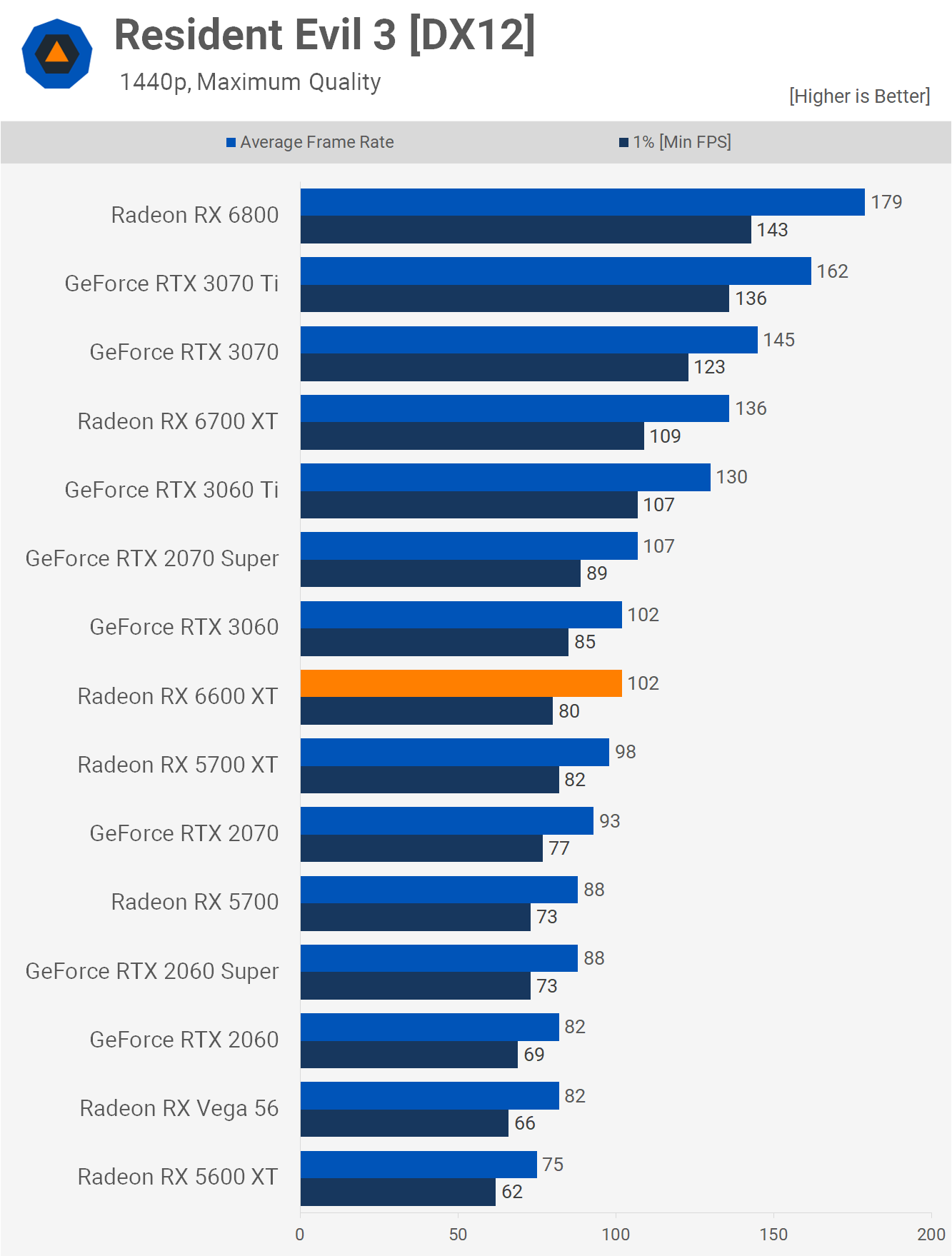
Resident Evil 3 has the 6600 XT good for 166 fps on average at 1080p. That's 7% faster than the 3060, while lagging behind the Ti version by 14%.
At 1440p we're still looking at a healthy 102 fps on average, though the new Radeon GPU was 22% slower than the 3060 Ti, which is a disappointing result overall.
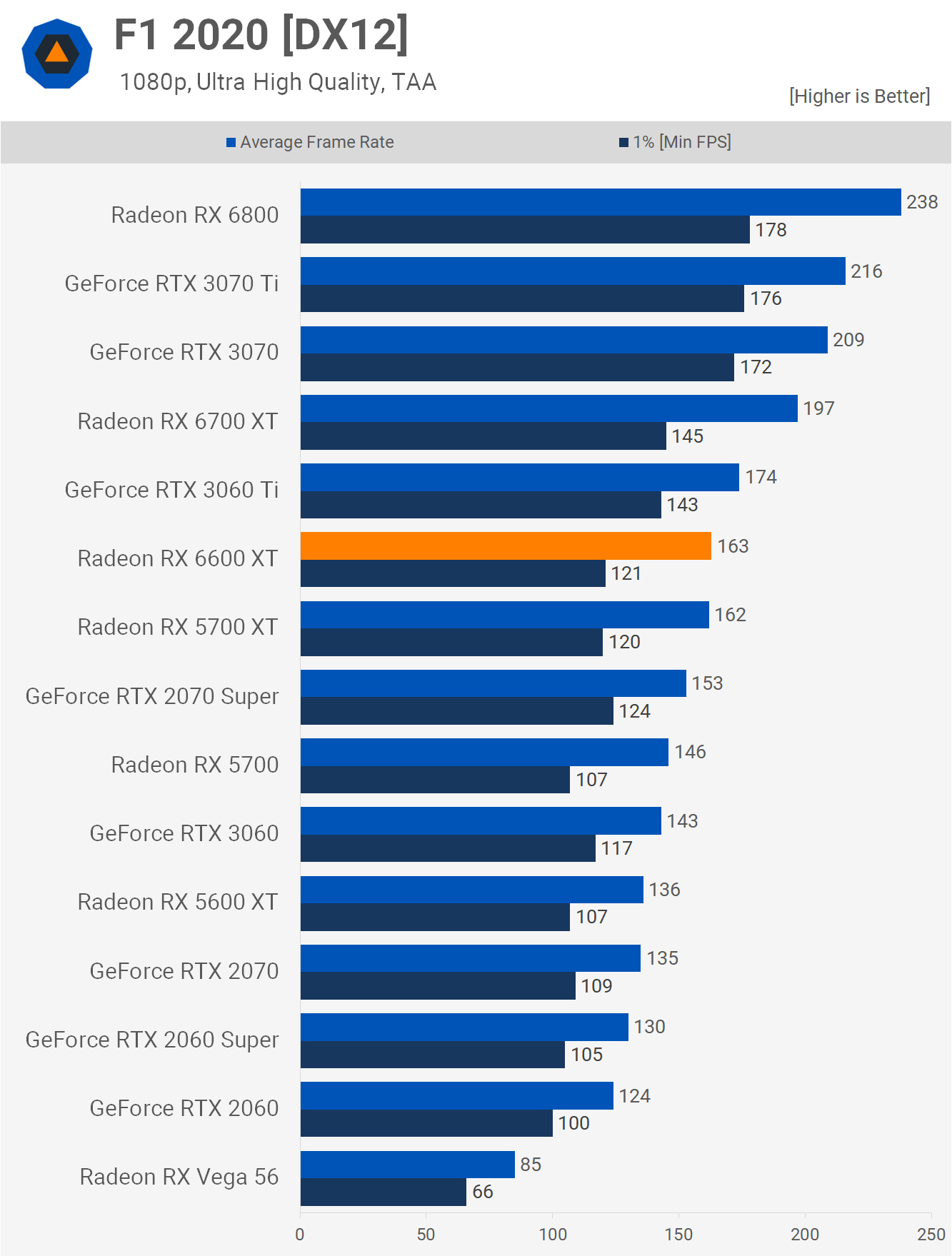
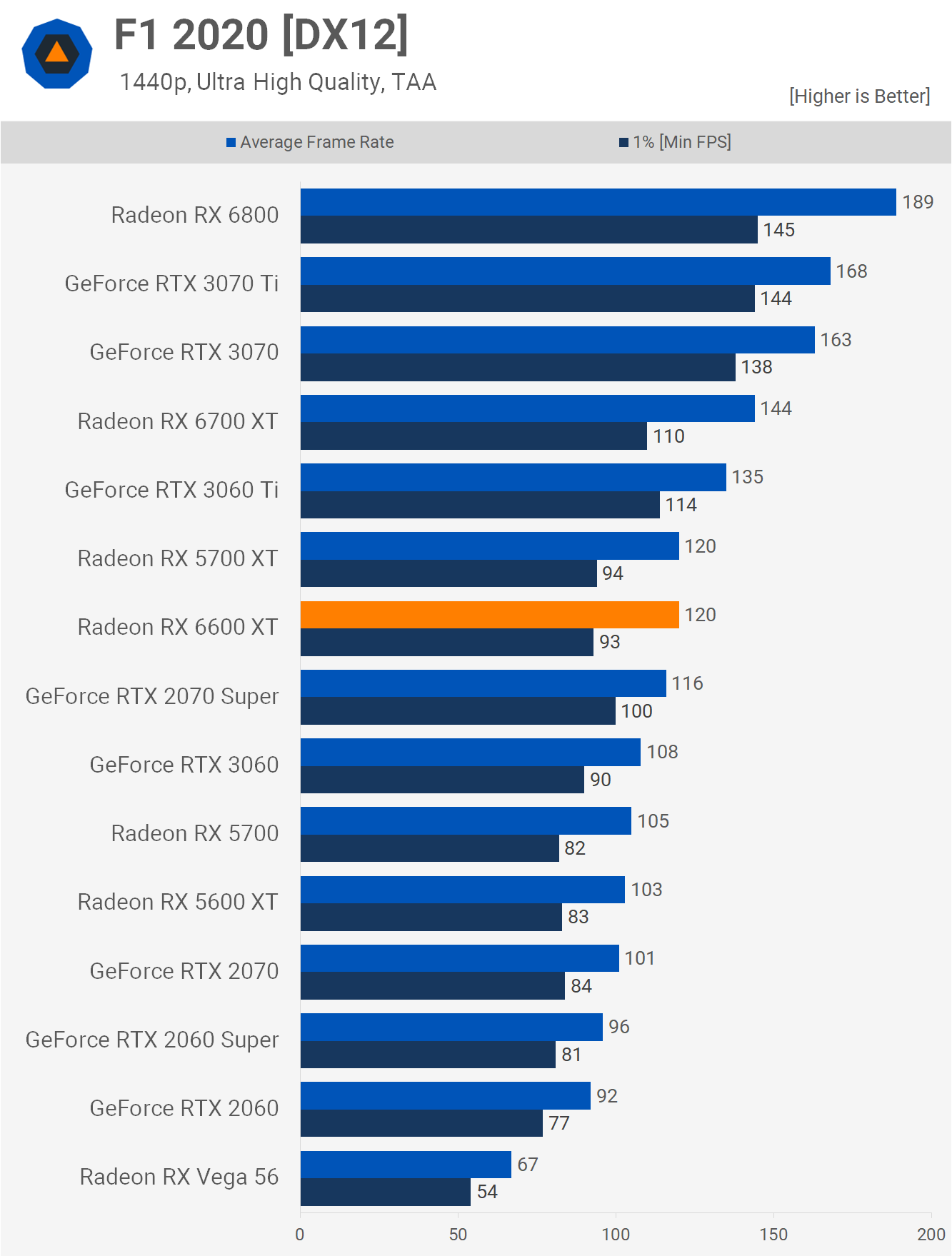
F1 2020 is another game where the 6600 XT is close to overkill at 1080p, rendering 163 fps on average using the highest in-game quality settings. That saw it trail the 3060 Ti by a 6% margin while besting the standard 3060 by a 12% margin, though at the end of the day you could just call it a 5700 XT.
1440p sees more 5700 XT-like performance and that meant the 6600 XT was again a little over 10% slower than the 3060 Ti. That's our look at all dozen games tested, now let's take a look at the average performance.
Average Performance
Here's a breakdown of the 1080p benchmarks from our 12-game sample. As you can see, the Radeon 6600 XT came out 9% slower than the 3060 Ti which is weak and won't position it well in terms of cost per frame, at least based on the mythical MSRP, but we'll get to that soon...
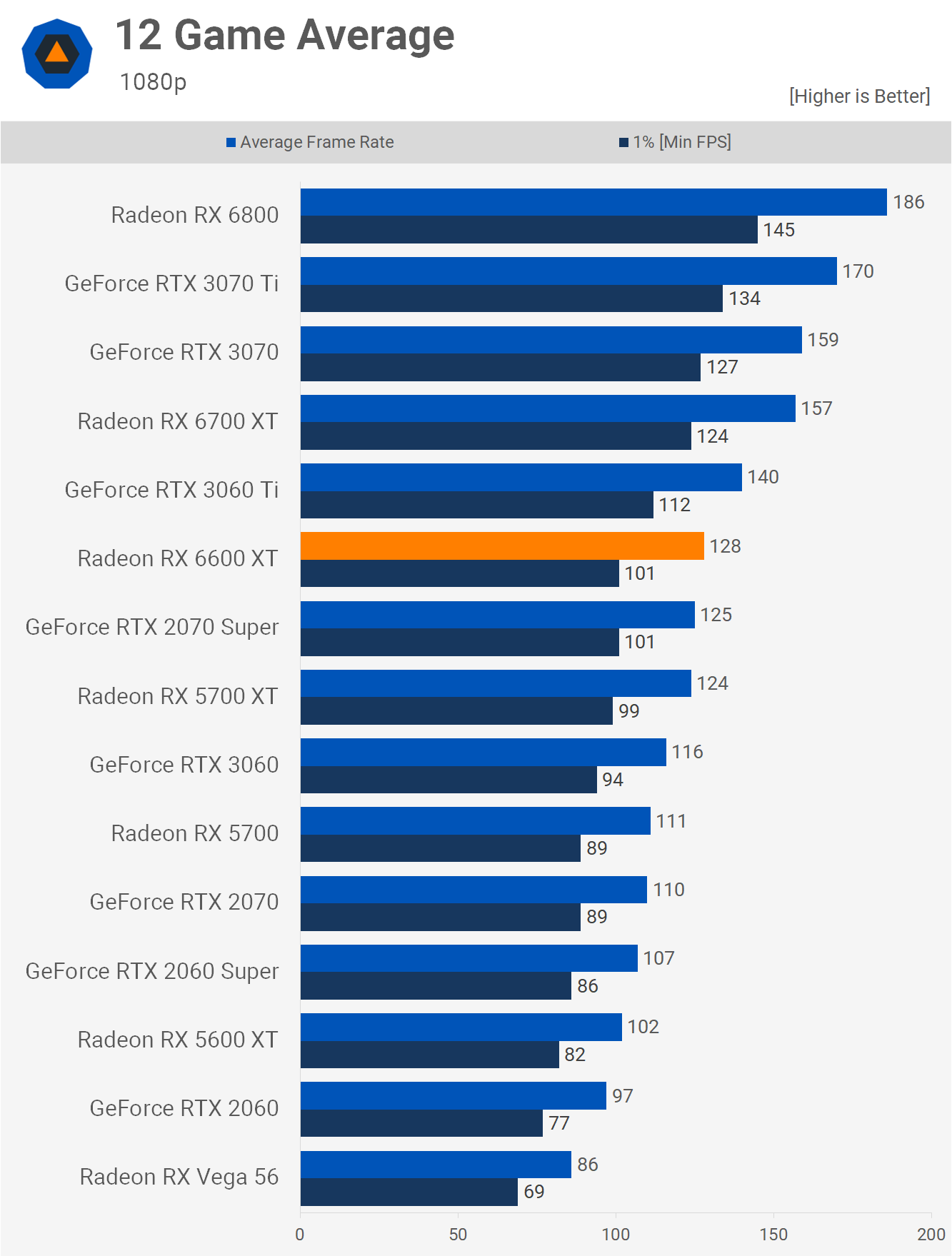
Even if we ignore the Ampere competition, the 6600 XT is still underwhelming when compared to AMD's previous efforts, such as the 5700 XT. For basically the same price, you're getting basically the same performance years later.
This really does look like AMD's Turing moment.
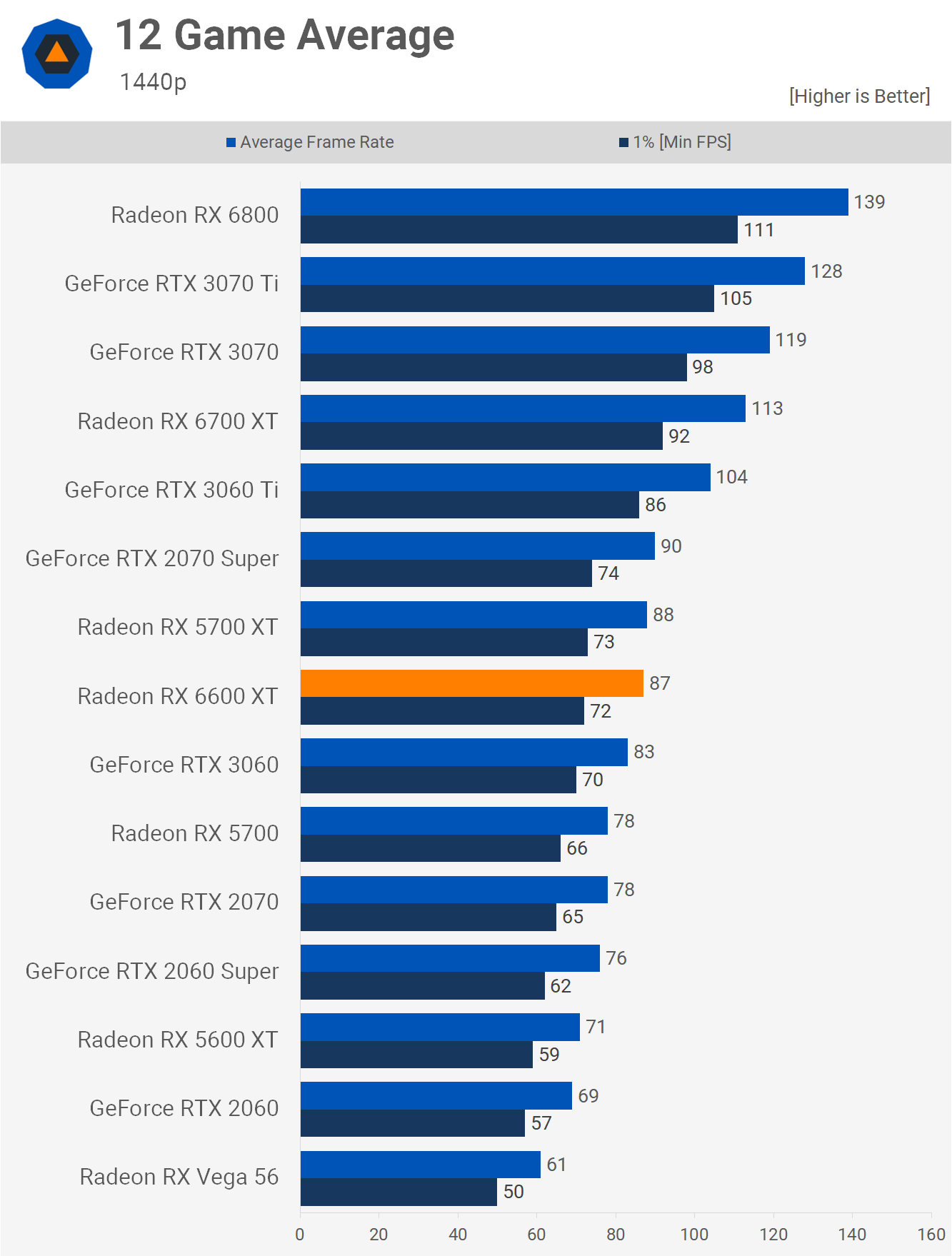
While AMD would like to tell you the 6600 XT is a 1080p gaming graphics card, the fact is many of you will want to use a ~$400 graphics card at 1440p and frankly that's not asking much. At this resolution the new GPU slips further behind the 3060 Ti, trailing it by 16% and showing it isn't much faster than the standard 3060 – and once again, it's basically a 5700 XT.
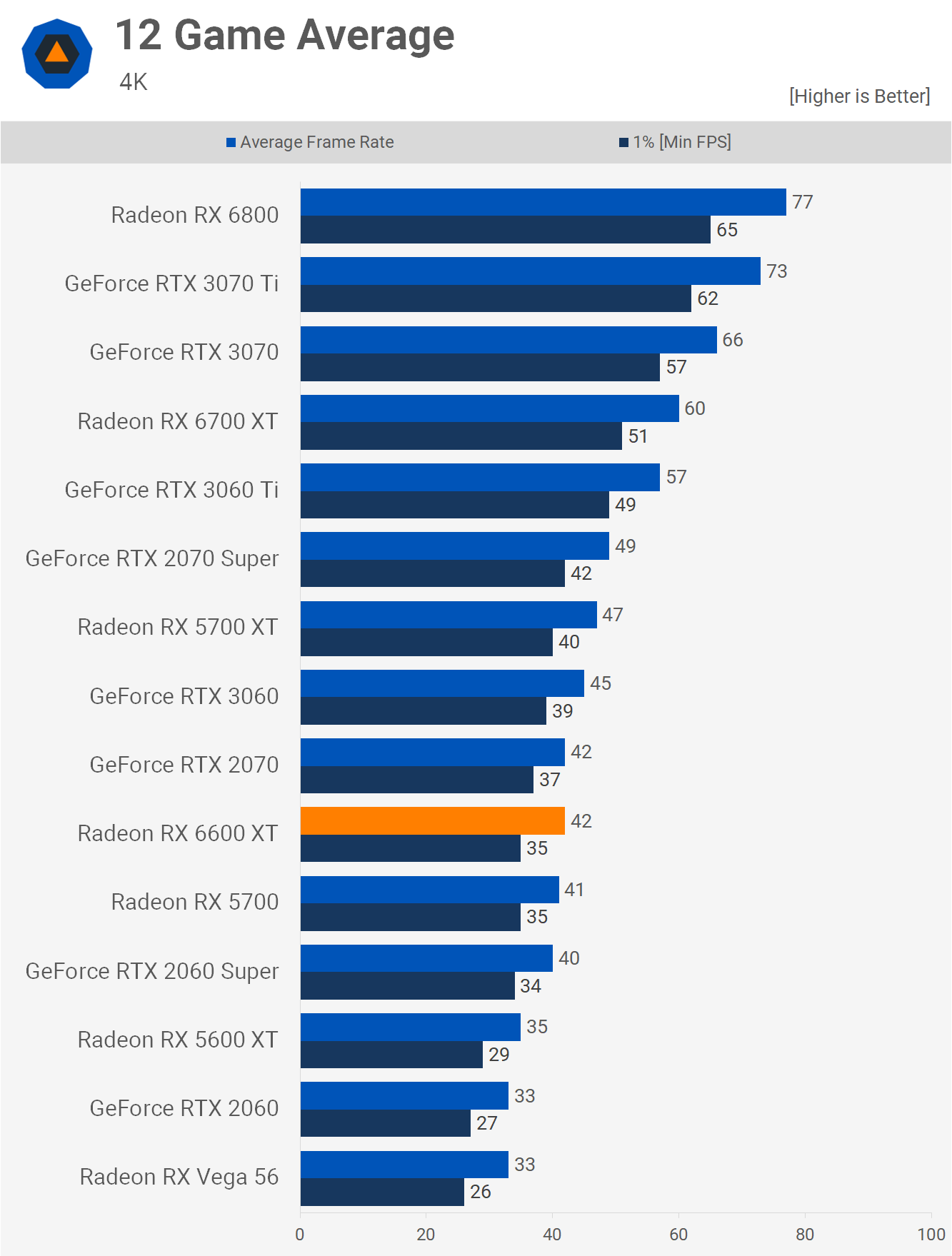
For those interested, here's what 4K gaming performance looks like. As games become more demanding, the 3060 Ti should still be able to deliver a 60 fps experience for the most part, while the 6600 XT could fall off a cliff due to its limited bandwidth.
Previously we saw that the 6600 XT was 9% slower than the 3060 Ti at 1080p, then 16% slower at 1440p and here at 4K it's 26% slower.
Power Consumption
Where the Radeon 6600 XT does shine is when looking at power consumption. In our test with Doom at 1440p, it used no more power than the older 5600 XT and yet it managed to deliver 23% more performance.

You're also looking at an increase of 100 watts for the total system with the 3060 Ti. So in terms of efficiency the 6600 XT is very good.
Ray Tracing
Now let's move on to some ray tracing testing and we'll start with Cyberpunk 2077, and please note due to limited time with these cards we've only compared the 6600 XT against the most relevant part, the RTX 3060 Ti. Standard rasterization performance saw the 6600 XT trail the 3060 Ti by a 14% margin at 1080p, and with both using ray traced reflections that margin blows out to a 44% deficit.
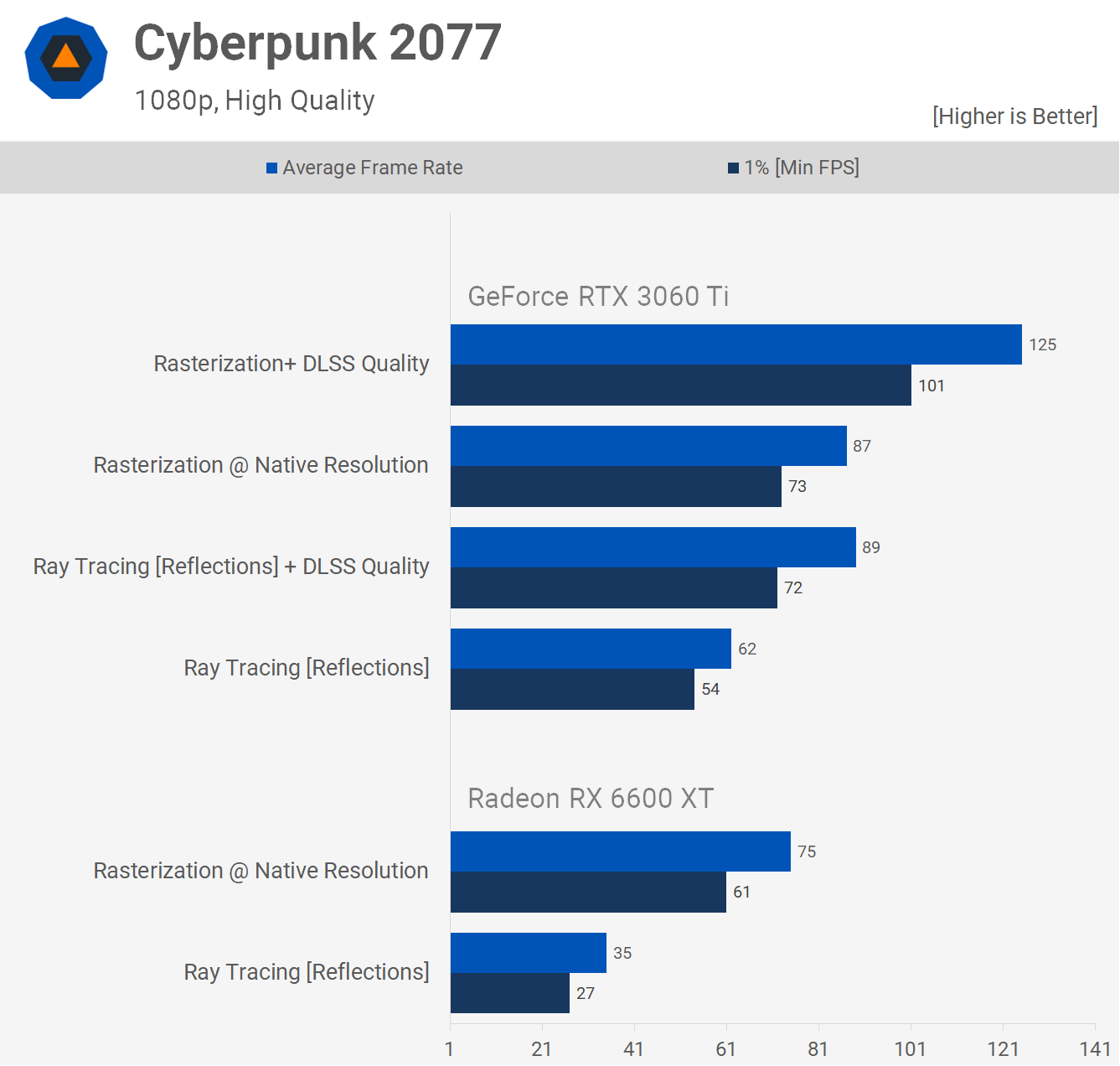
Without the aid of DLSS, the RTX 3060 Ti can deliver playable performance whereas the 6600 XT simply cannot. Worse still, there's no way to boost the performance of the Radeon GPU outside of lowering other quality settings.
Using DLSS the 3060 Ti can be boosted back to almost 90 fps on average and while it's not an apples to apples image quality comparison, it's still an option to achieve much greater performance with ray tracing enabled. Alternatively, you can use DLSS without ray tracing for an impressive 125 fps on average.
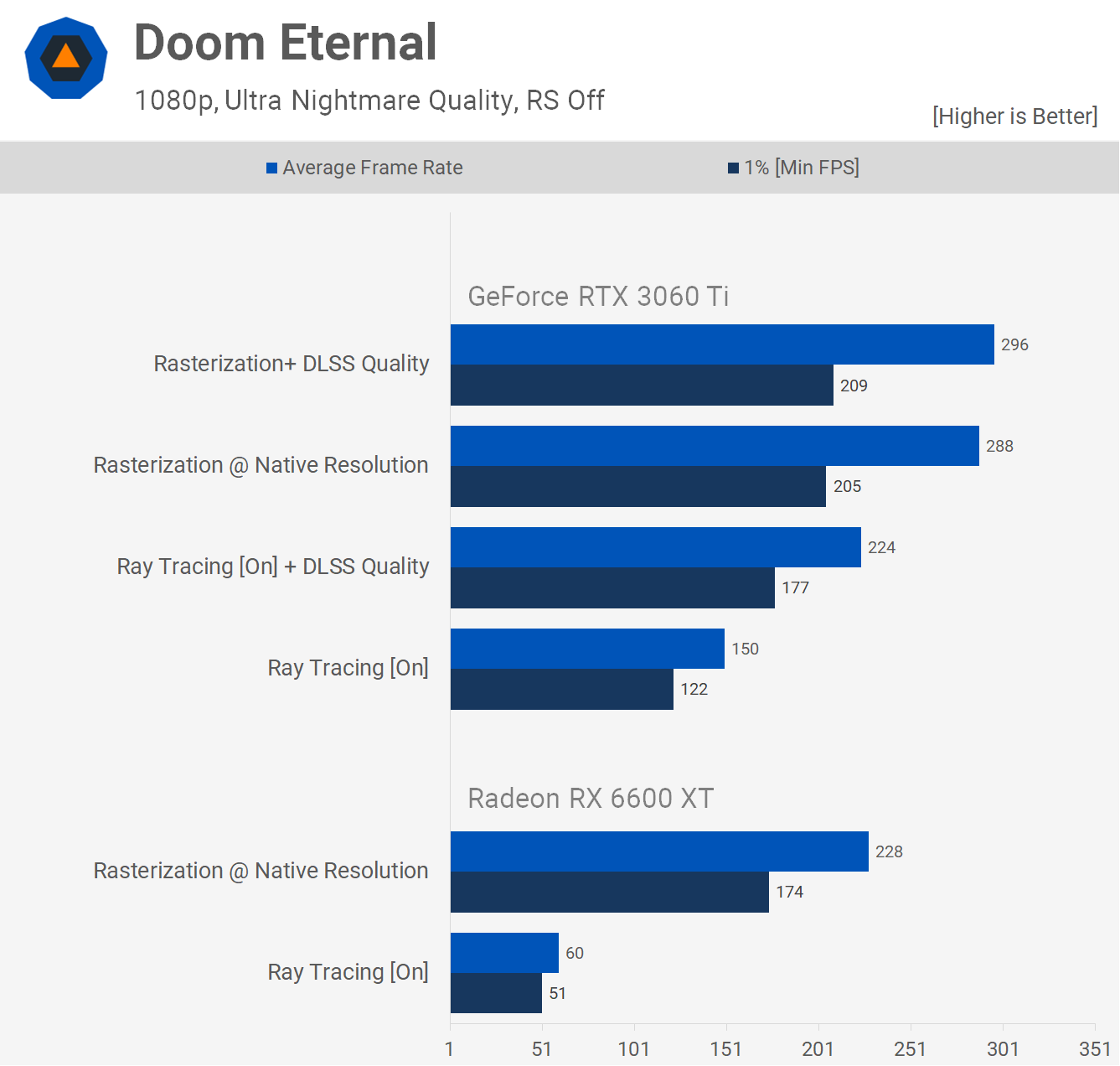
Doom Eternal is even more brutal for the 6600 XT, dropping from 228 fps on average to just 60 fps with ray tracing. Meanwhile, the RTX 3060 Ti dropped from 288 fps to 150 fps and while that's an extreme 92% performance hit, the frame rate at 1080p was still far more than what most gamers would require at 150 fps on average.
Enabling DLSS reduced the performance hit to just 29%. But even without it, the 3060 Ti was 150% faster than the 6600 XT with ray tracing enabled, so we're not sure the word 'brutal' really conveys just how much of a smashing that really is.
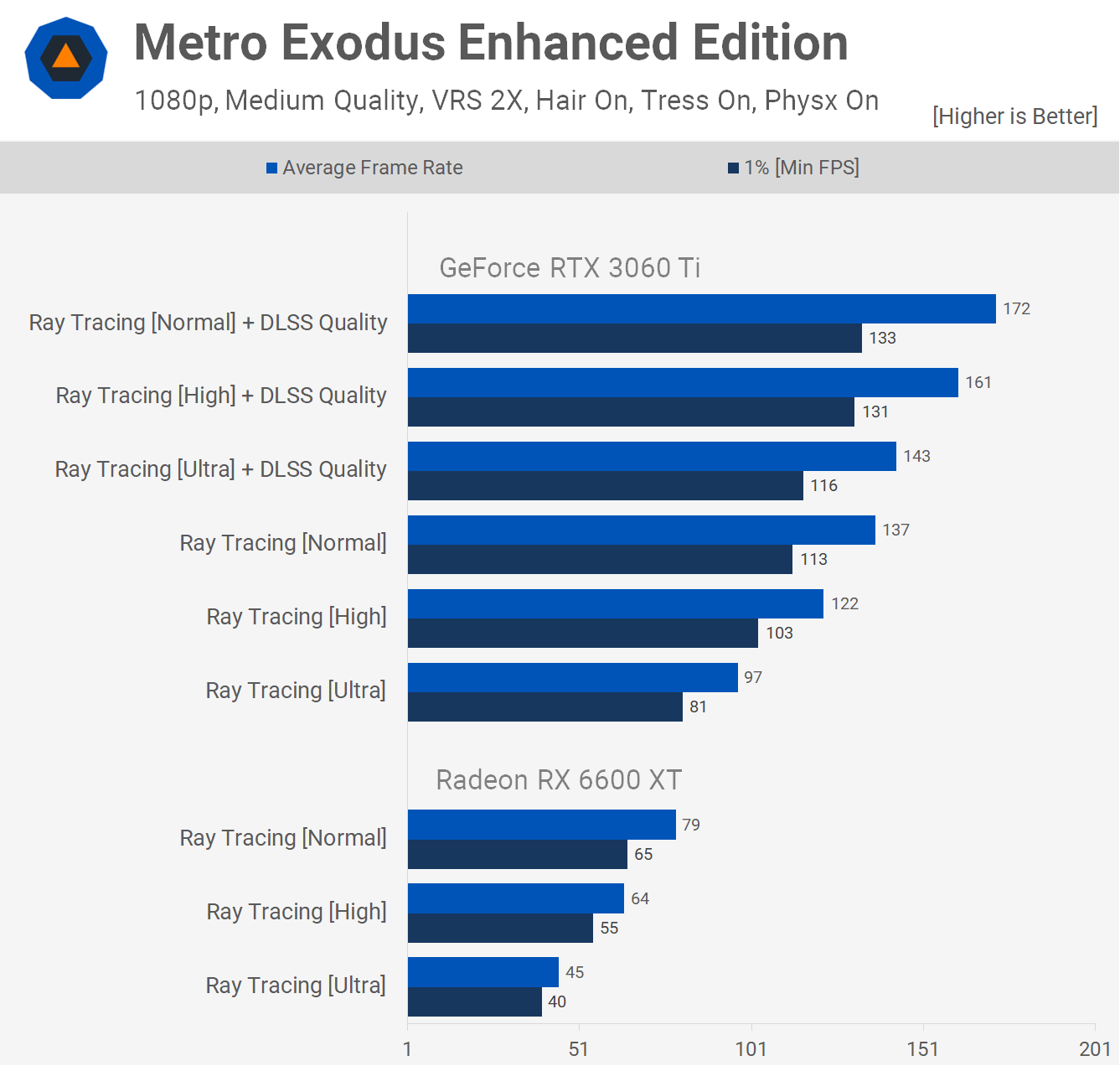
Metro Exodus Enhanced Edition can only be played with a GPU supporting real-time hardware accelerated ray tracing and is therefore enabled by default. Using the lowest level, which is labeled as 'normal', the 6600 XT was almost 50% slower than the 3060 Ti and although it did still deliver playable performance, 137 fps is worlds better than 79 fps.
In fact, with the highest level of ray tracing enabled at 1080p, the 3060 Ti was good for 97 fps on average while the 6600 XT struggled with just 45 fps. Then with DLSS it was possible to boost performance up to 143 fps, so another ray tracing bloodbath here.
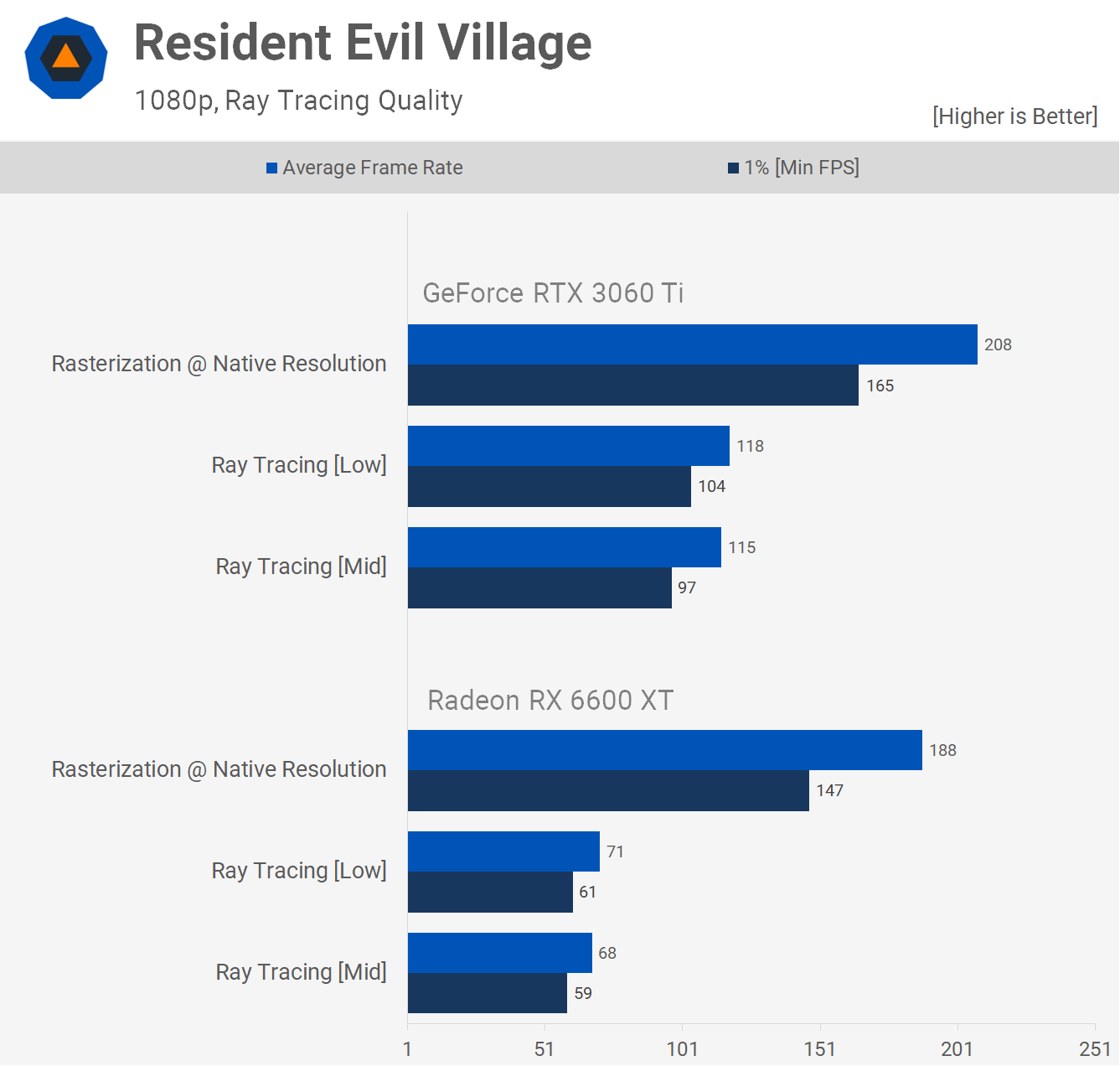
Even in Resident Evil Village the 6600 XT couldn't hold a candle to the ray tracing performance of the 3060 Ti, offering ~40% less performance using the low and mid tier options.
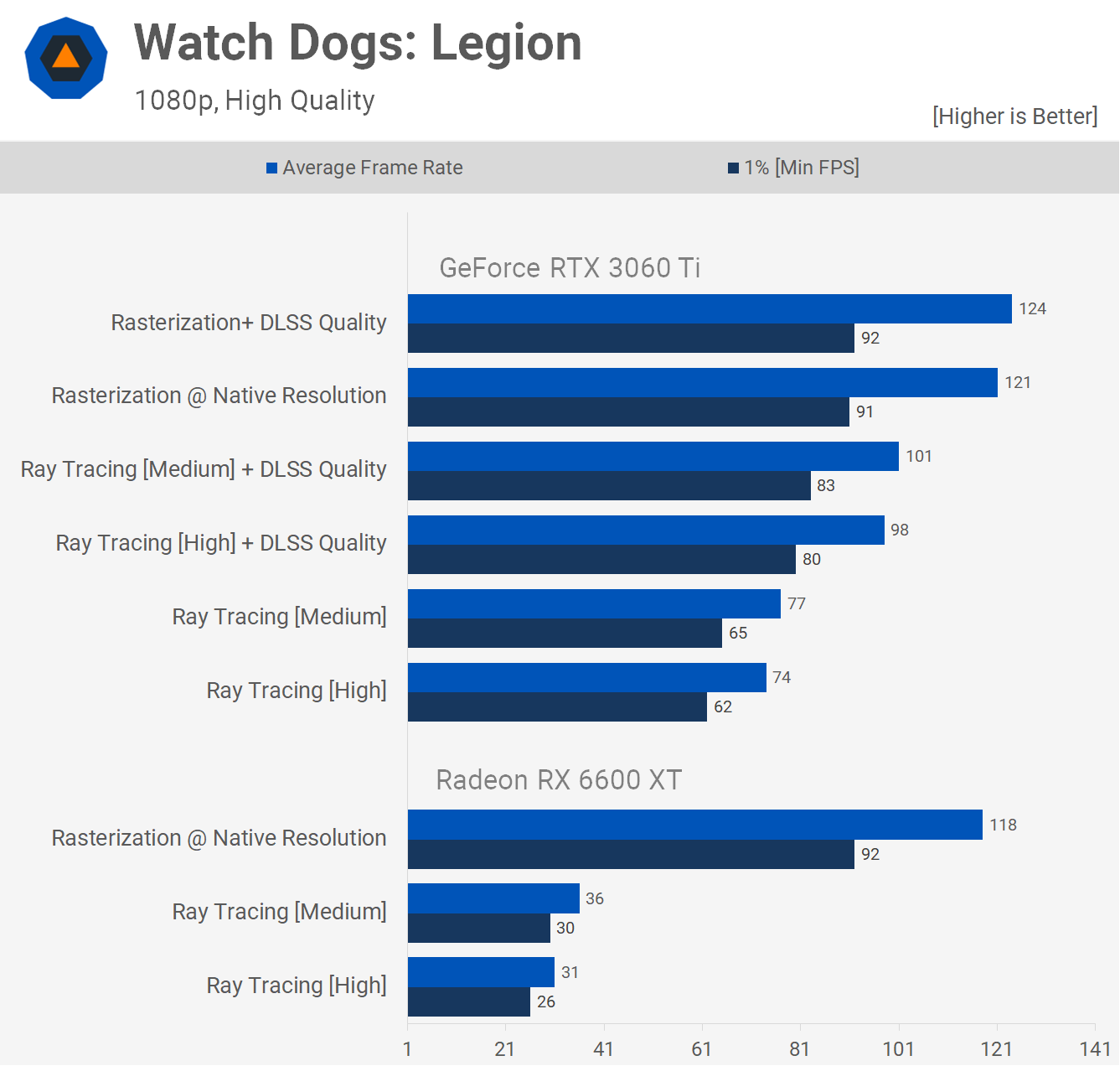
Then we have the Nvidia sponsored Watch Dogs Legion and no surprises, the 6600 XT gets dominated and is unable to deliver playable performance, dropping from an impressive 118 fps without ray tracing to just 36 fps using the medium quality settings.
PCI Express Testing
As mentioned earlier, the Radeon 6600 XT is limited to PCIe Express x8 bandwidth, which is fine if you're running in PCIe 4.0 mode, but could be an issue for those with PCIe 3.0 systems.
The performance hit running Assassin's Creed Valhalla at 1080p is fairly minimal, though we are looking at a 5% reduction in performance and that does bring the 6600 XT closer to the 3060 Ti in a title where previously it had quite a large performance advantage.
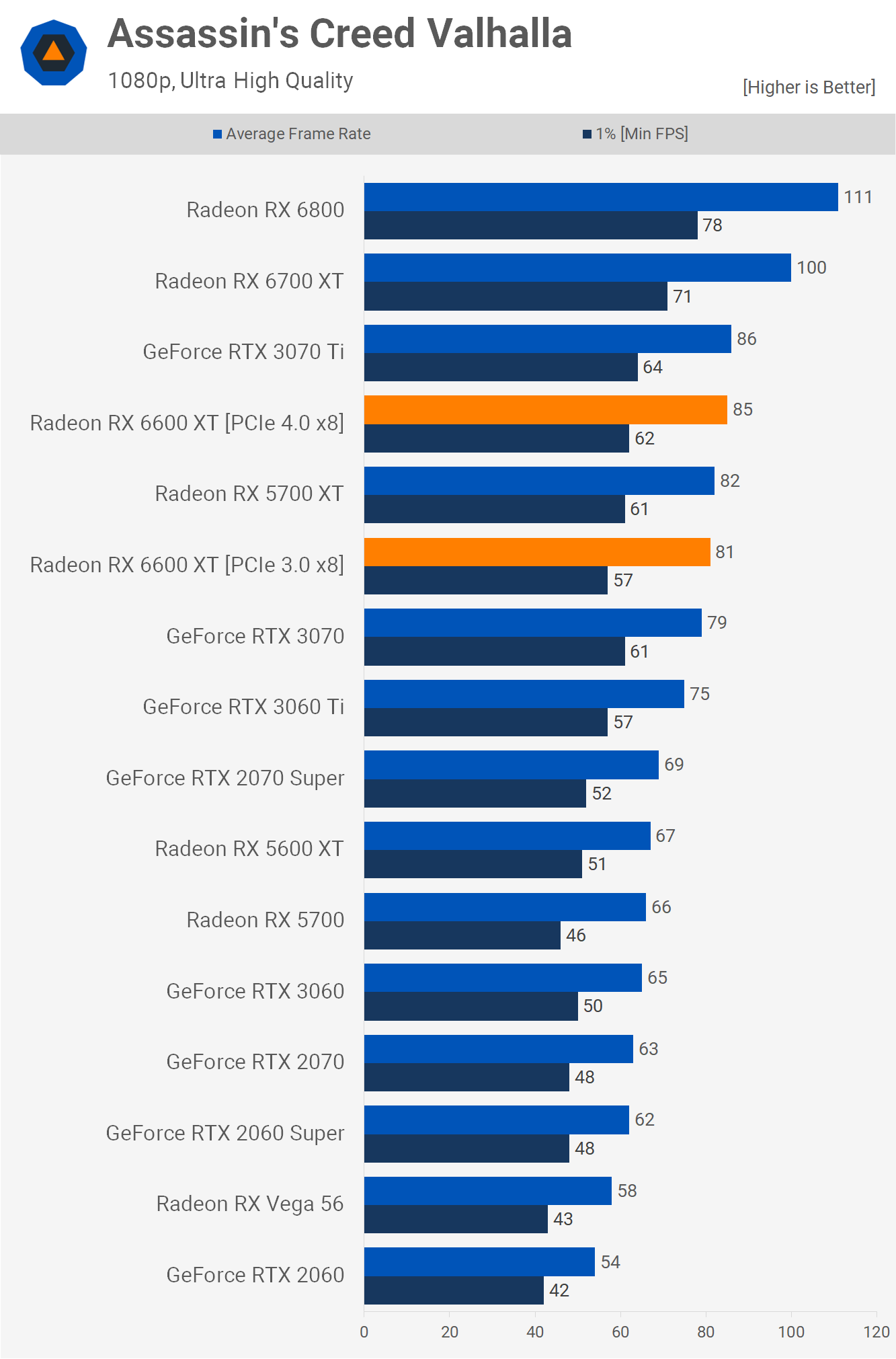
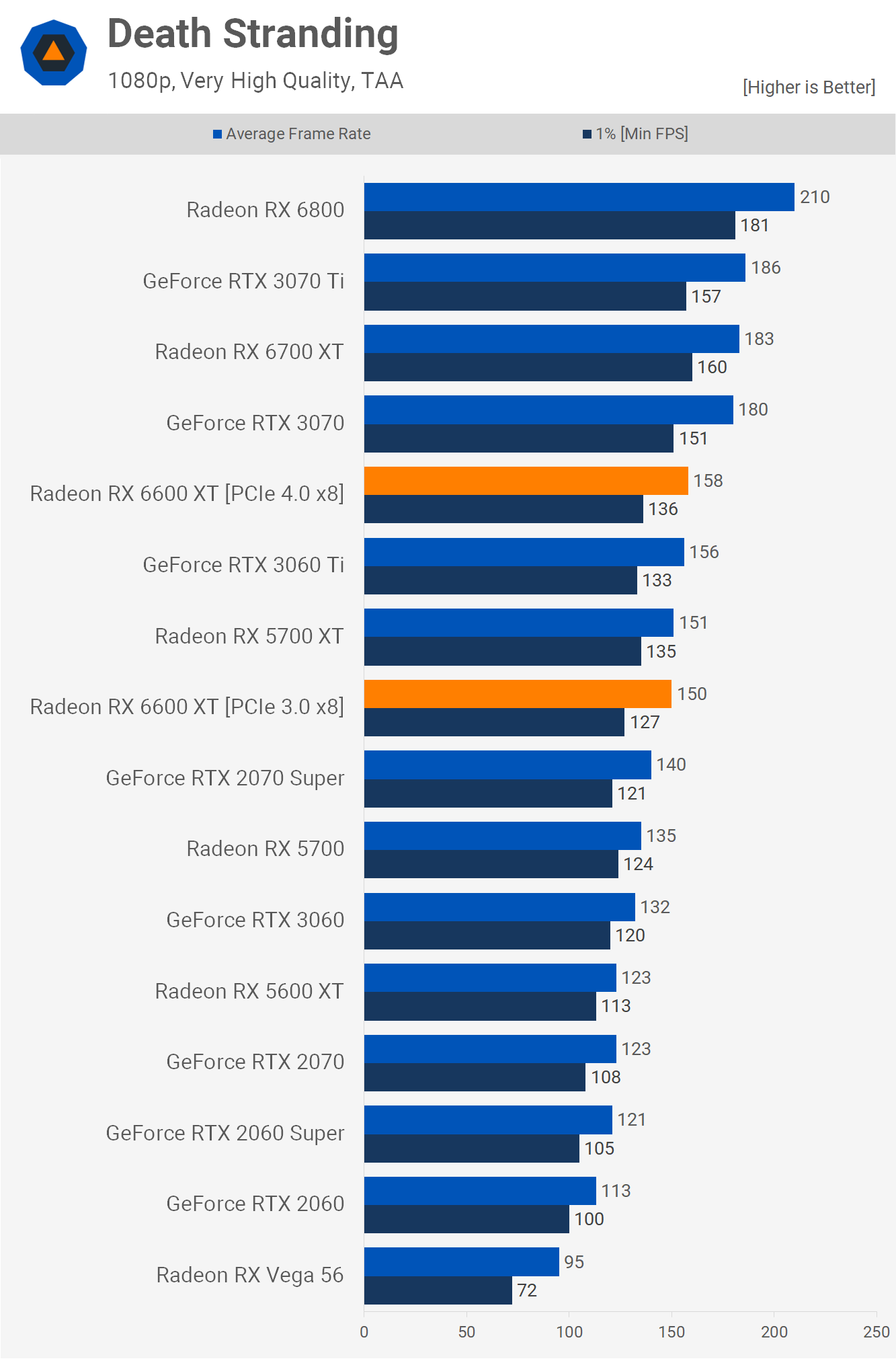
We also found a 5% reduction in performance when testing with Death Stranding and this saw the 6600 XT go from slightly leading the 3060 Ti to trailing it by a small margin.
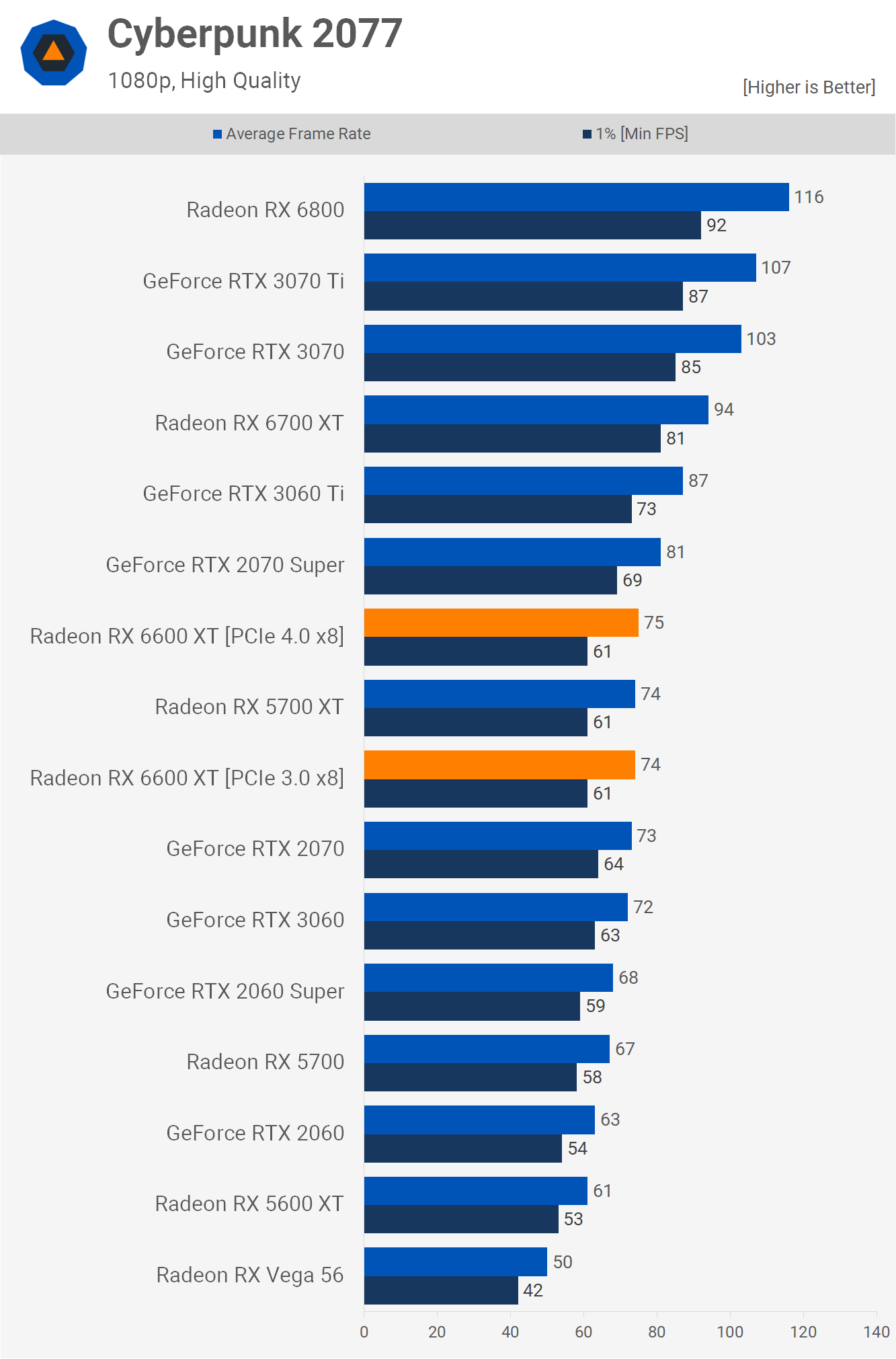
However, in some games the reduced PCIe bandwidth makes no difference and we see that in Cyberpunk 2077.
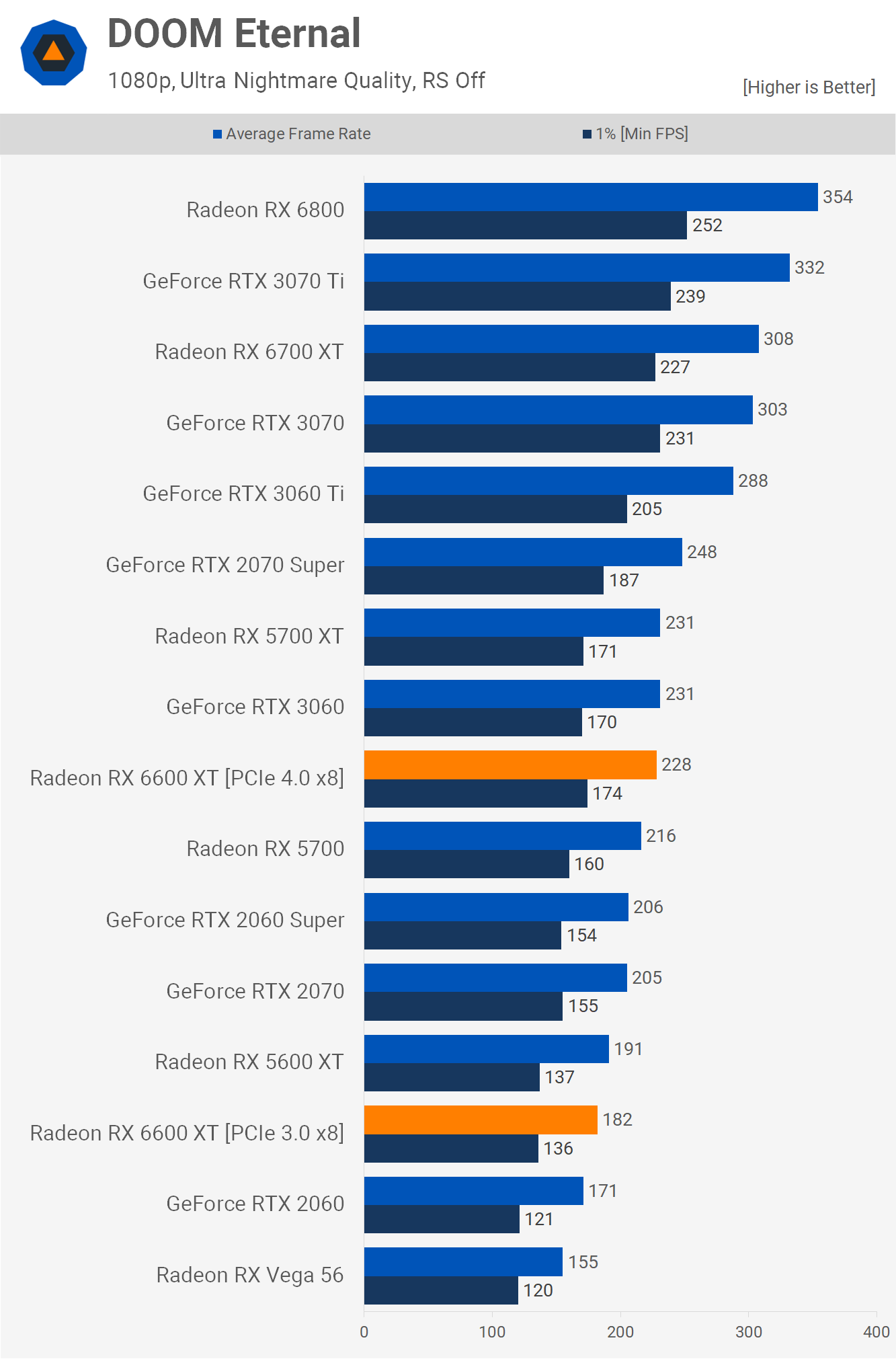
As we've seen before, Doom Eternal is very memory intensive when using the Ultra Nightmare setting, and while we could simply tune the settings for better results, I'd rather take a look at how these graphics cards perform when saturated as it should provide some insight into future performance.
When I saw performance drop from 228 fps to just 182 fps when using PCI Express 3.0 my immediate reaction was something else had changed, maybe a quality setting or even the resolution. But we double-checked everything and after several back and forths it became clear that this massive 20% drop in performance was due to the PCIe mode.
This means when using both the RTX 3060 and 6600 XT in a PCIe 3.0 system while playing Doom under these conditions, the GeForce GPU will be almost 30% faster. Just as shocking is that we found a way to make the 6600 XT slightly slower than the 5600 XT as the older 5000-series part supports x16 bandwidth.

Of the 12 games tested, we found that the 6600 XT was just 3% faster using PCIe 4.0 on average, or 5% faster if we include the Doom Eternal result. For the most part those with PCIe 3.0 systems should receive fairly similar performance to what's shown using PCIe 4.0, but in extreme cases the margin can be more significant and this is possibly something we could see more of over the next few years, so I can't say I'm particularly impressed with AMD's decision to potentially gimp the performance of the 6600 XT in this way.
Cost Per Frame
Let's start our analysis by looking at cost per frame using the MSRP, which has become a suggested price that's no longer remotely accurate. Even if demand dried up overnight which isn't possible, but let's say it did, would we see a return to MSRP pricing then? We probably would for future releases, but I doubt that would be the case for current generation products.

Pricing for this generation was almost set in stone when Nvidia released Ampere back in September 2020. Since then a lot has changed. Besides the natural demand from gamers and then miners, shipping costs have risen, various tariffs have been introduced, and prices for not just components but also raw material has increased, in some instances quite significantly.
Since the release of the GeForce RTX 30 series, raw material prices have risen by 30 to 50%. Materials like copper, aluminum, and even plastics, for example. Now, if demand did dry up for graphics cards, that doesn't mean pricing of DRAM along with all the raw materials would decrease as demand would likely continue from numerous other sources. That means getting 6600 XT's on shelves for the $380 US could be extremely tight and perhaps not even possible without selling them at a loss.
Right now and likely for the foreseeable, the MSRP is BS. But if it weren't, well, the 6600 XT would kind of suck, offering worse value per frame than both the RTX 3060 and 3060 Ti while offering inferior ray tracing performance, no true DLSS competitor and a gimped PCI Express interface.
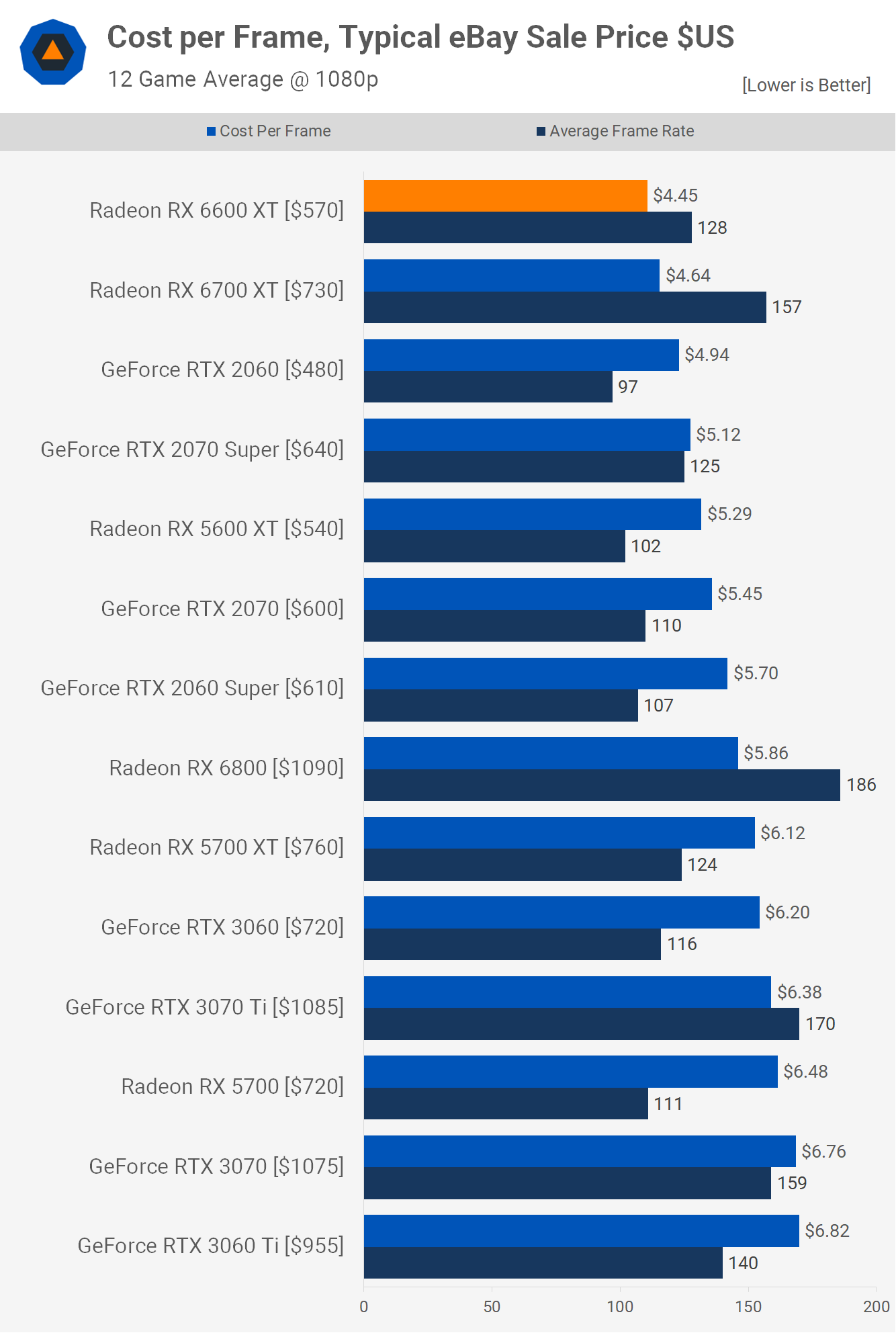
For a more realistic take on pricing, let's look to eBay in the US. What we're looking at here is the typical sale price for each product on eBay over the past month, though of course the 6600 XT hasn't gone on sale yet, so we're using the same markup as the 6700 XT as that's likely where it'll end up.
If you're confused by the 3060 Ti pricing, it is very close to the 3070 Ti after all, that's because the demand for the 3070 Ti from miners is lower as all 3070 Ti models are 'Lite Hash Rate' and therefore aren't as efficient for cryptocurrency mining.
Likewise, the demand from crypto miners for the Radeon RX 6000 series is lower, as the Infinity Cache and RDNA 2's relatively small memory bus width doesn't make them terribly efficient for mining.
The 6600 XT probably won't be a sought-after mining card and therefore should end up being one of the most affordable current generation GPUs, estimated to be coming in around $570 at a cost of $4.45 per frame. In that sense, it should be fairly decent value and I guess that's what AMD's banking on.
Temperatures
Before we wrap this up, here's a quick look at how the MSI Gaming X version of the 6600 XT performed in our GPU test system, which is an enclosed setup using the Corsair Obsidian 500D.
Under load for 30 minutes, the GPU hotspot temperature peaked at 80 C with a peak edge temperature of just 67 C. The cores clocked at 2640 MHz on average which is about an 8% increase over the AMD reference spec. This also raised the GPU power to 145 watts which is 15 watts above stock.
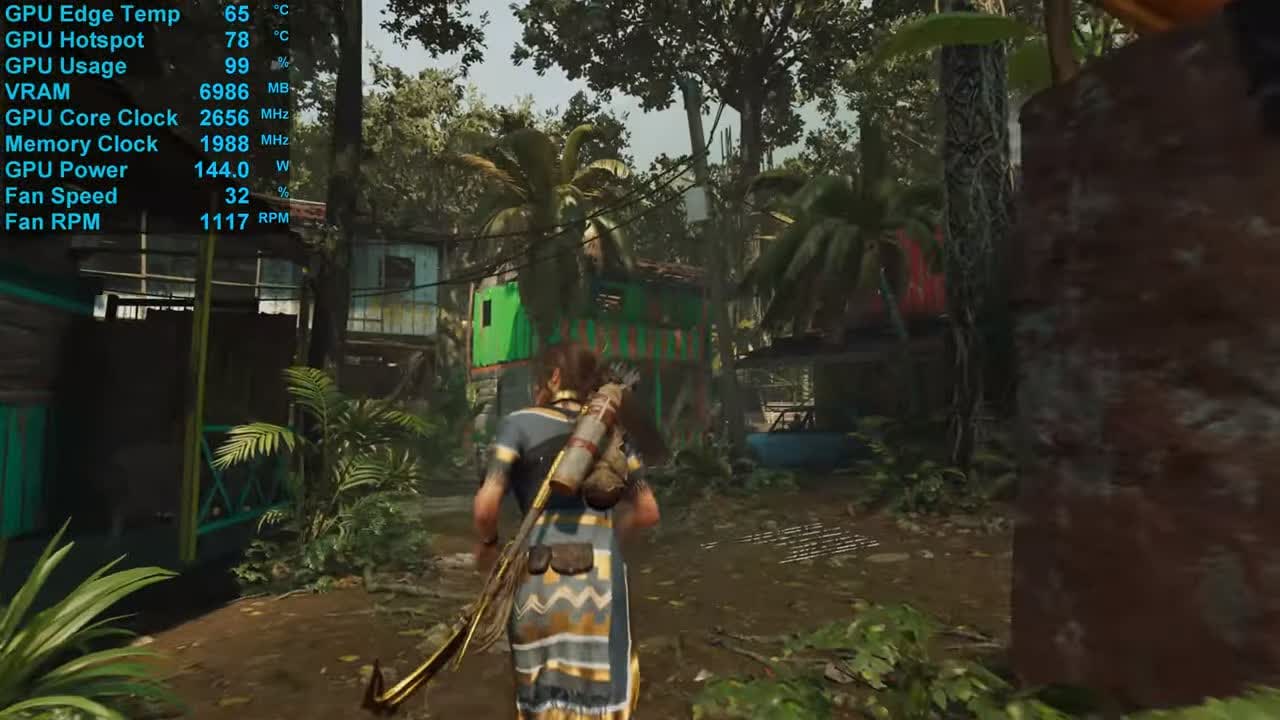
Despite the small overclock, the Gaming X ran cool and extremely quiet with the fans operating at just 1100 RPM. Overall, that's a fantastic result for what is a well-made graphics card. My only complaint, and it is a bit of a frustrating one, is that it doesn't feature a dual BIOS.
What We Learned
The Radeon RX 6600 XT is as close as it gets to an RX 5700 XT in terms of pricing and performance, with the addition of ray tracing and DirectX 12 Ultimate support. It's an underwhelming release at a time when we weren't expecting to be wowed.
However, I do feel AMD managed to make the 6600 XT even worse than anticipated by gimping the PCI Express interface and heavily reducing the Infinity Cache capacity, making this GPU weaker than expected, particularly for 1440p gaming.

If the suggested retail pricing was effective on the 6600 XT and the rest of the market, this release would be a joke, the laughing stock of the RDNA2 lineup. Even based on the 1080p data, it's worse value than either of Nvidia's offerings in terms of rasterization performance, and of course, it gets worse as you increase the resolution.
The only good thing I can say about the Radeon RX 6600 XT is that it sips power, and due to the lower demand you should be able to buy it. Even so, although we anticipate that the 6600 XT will be the best value option at places like eBay, it's hard to get excited about. Had AMD made the MSRP $300, then sure the 6600 XT would be a pretty decent offering and honestly given the ray tracing performance, lack of a true DLSS competitor for 1080p gaming, and the PCIe limitations, that's the most AMD should be charging for this part.
But of course, with the industry being what it is right now, AMD's basically saying they'll happily make their margin on the $380 MSRP because you have no choice but to buy it at whatever that translates into in the real world. At the end of the day, if these are widely available for $570, AMD would be able to sell a good deal of them, probably.

If we take a local PC part seller as an example, we can see that anything high-end is really hard to buy, even at the extreme prices. However, parts like the RTX 3060 Ti and 6700 XT or lower are easier to purchase, albeit at inflated prices. I believe this is because gamers with deep pockets who have their sights on a high-end graphics card are willing to spend whatever they need to and not as willing to wait.
Whereas buyers on a tighter budget are the opposite. They're less willing to participate in price gouging and more patient, and are therefore likely to wait it out. So overpriced RX 6700 XTs and RTX 3060 series graphics cards aren't selling nearly as rapidly as expected and demand for the mediocre 6600 XT is almost certainly going to be even lower.
We've been told by a retailer that as soon as parts like the 3060 Ti are available for under $750, they fly out the door. Basically it's not possible to keep them in stock at $650. So this supports my theory regarding mid-range shoppers.
Availability and Pricing
Right before going live, we received some last-minute information from retailers and AMD. AMD seems very confident that you'll be able to purchase a 6600 XT at or very near the MSRP. Yes, we've heard that one before. However, checking in with retailers it does sound like that might actually be true, at least for the initial wave of stock which we're told is substantial compared to previous releases this year.
This sounds pretty crazy, but I have been told by retailers, that there will be 6600 XT models available on Aug 11 selling at the MSRP. If that's the case, then the 6600 XT could be significantly cheaper than both the RTX 3060 and 3060 Ti, and if so it'll be worth buying and a highly successful release. But everything hinges on pricing and availability. If what we're hearing is true then the 6600 XT might actually end up being a sought-after GPU, despite its various shortcomings.
